Everyone loves doughnuts. Even when you’re watching your waistline, it’s hard to resist these soft, pillowy, deep-fried rings of doughy goodness. As far as I know, doughnuts in some form exist in every culture and there’s a simple reason for that. They’re effing delicious.
We’ve enjoyed different types of donuts from many countries around the world and as far as I can remember, I’ve never bitten into a donut I didn’t like. It’s a universally beloved comfort food, one that never fails to bring a smile to people’s faces. Even hearing the word “donut” makes me happy.
So in the spirit of bringing good cheer to people reading this blog, I’ve put together this list of the most delicious types of donuts from around the world. From the classic jelly donut to chewy pon de ring in Japan, this list will give you forty reasons to smile.
Save This on Pinterest!
No time to read this article on the different types of donuts from around the world? Click on the save button and pin it for later!
Photo by bhofack2
WHAT IS A DONUT?
If someone asks you to draw a donut (or doughnut), then you’d probably sketch something that looks like a ring. A sweet ring of fried dough is usually the first thing that comes to mind when people think of donuts. It’s the most common type but it’s hardly the only one.
While donuts are indeed made with deep-fried dough, they aren’t always shaped like rings nor do they have to be sweet. They can be savory like Ukrainian pampushky and Indian vada or shaped like ridged cigars like Spanish churros.
Donuts filled with fruit preserves are as common as ring-shaped varieties while small spheres of fried dough are referred to as drop donuts or donut holes. Donuts are commonly made with flour dough though they can be made with other types of batter as well.
In summary, donuts are deep-fried pastries that can be made in a seemingly endless variety of shapes, sizes, flavors, and fillings.
WHAT ARE THE BASIC TYPES OF DONUTS?
In this section, we’ll talk briefly about some of the most common types of batter used to make donuts.
Yeast Donut
As its name suggests, yeast donuts are made from dough leavened with yeast. They’re light, puffy, a little chewy, yeasty, and with little to no sweetness. Yeast donuts typically get their flavor from the glaze, filling, or sugar coating.
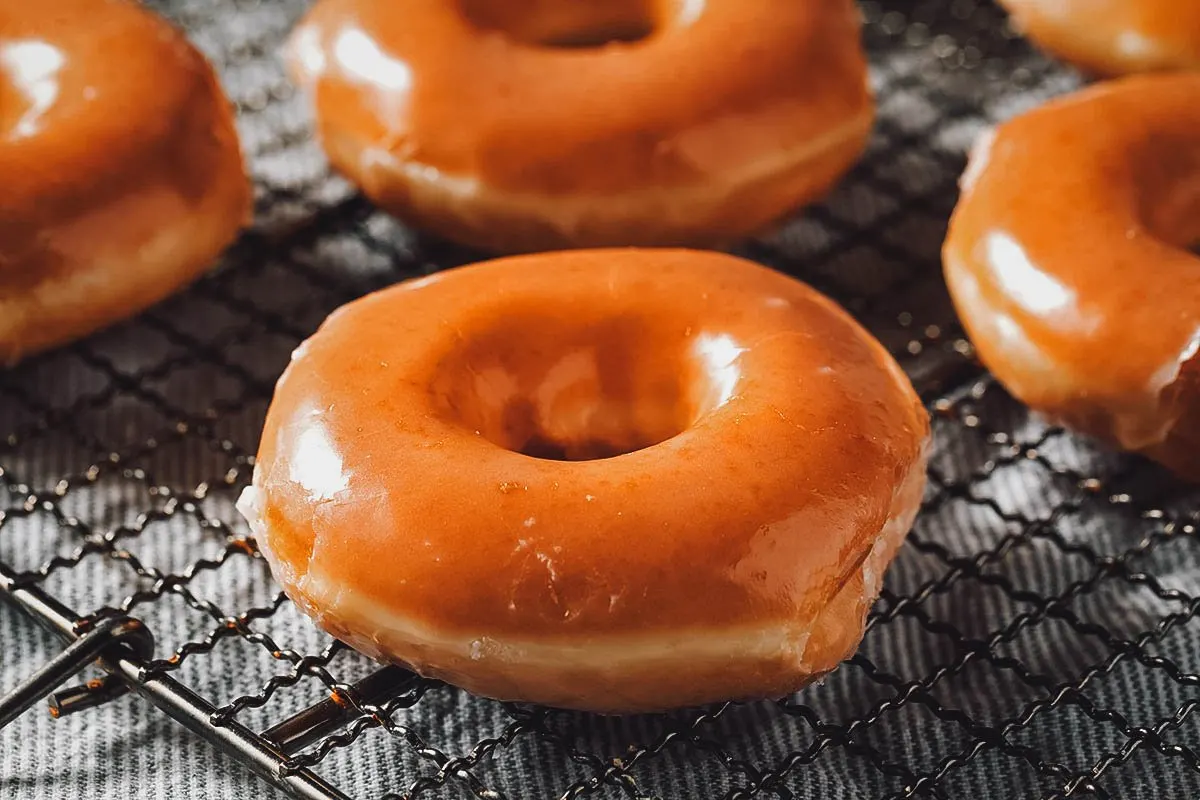
Photo by bhofack2
Cake Donuts
Cake donuts are made from a cake batter that uses a chemical leavener like baking soda or baking powder. They’re much denser and more cake-like in texture than yeast donuts. They have a more compact crumb and tend to stick to the roof of your mouth when eaten.
Flavor-wise, a cake donut is richer and more buttery thanks to the large amount of butter that usually goes into the batter.
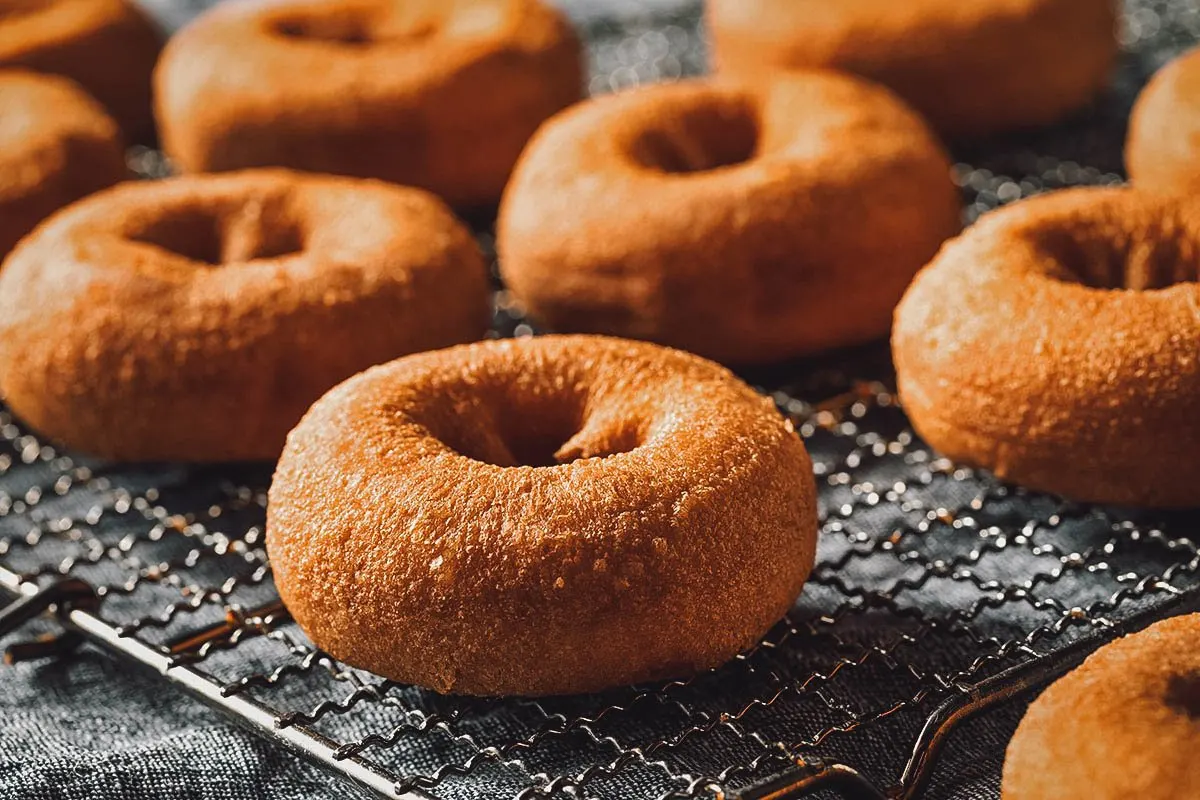
Photo by bhofack2
Potato Donut
Potato donuts are made with the same ingredients as yeast donuts, except all or most of the flour is replaced by mashed potatoes or potato starch. They tend to be even lighter and airier than regular yeast donuts.
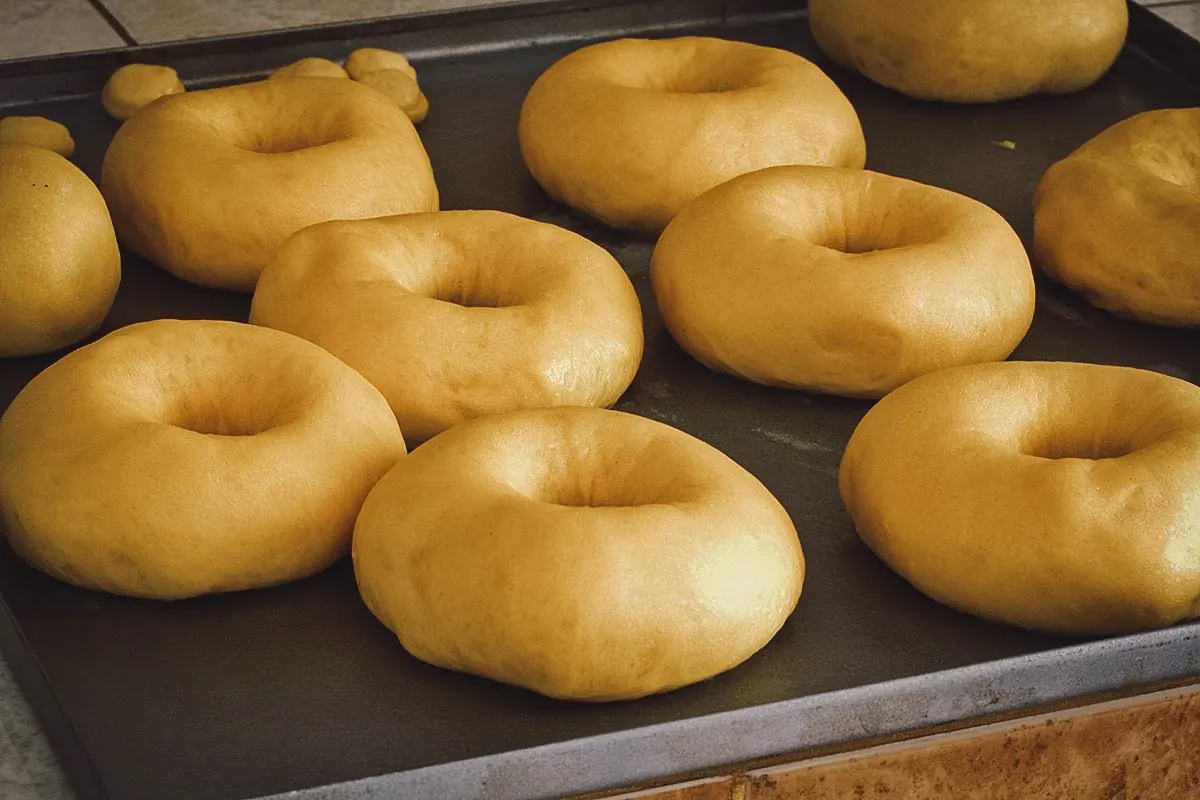
Photo by [email protected]
Mochi Donut
The mochi donut is a type of Japanese-American cake donut made with either glutinous rice (mochi) flour or tapioca starch. They’re lighter and stretchier in texture than regular cake donuts and can be either fried or baked.
Because they can be made without all-purpose flour, mochi donuts are also gluten-free and can be viewed as a healthier alternative to cake or yeast donuts.
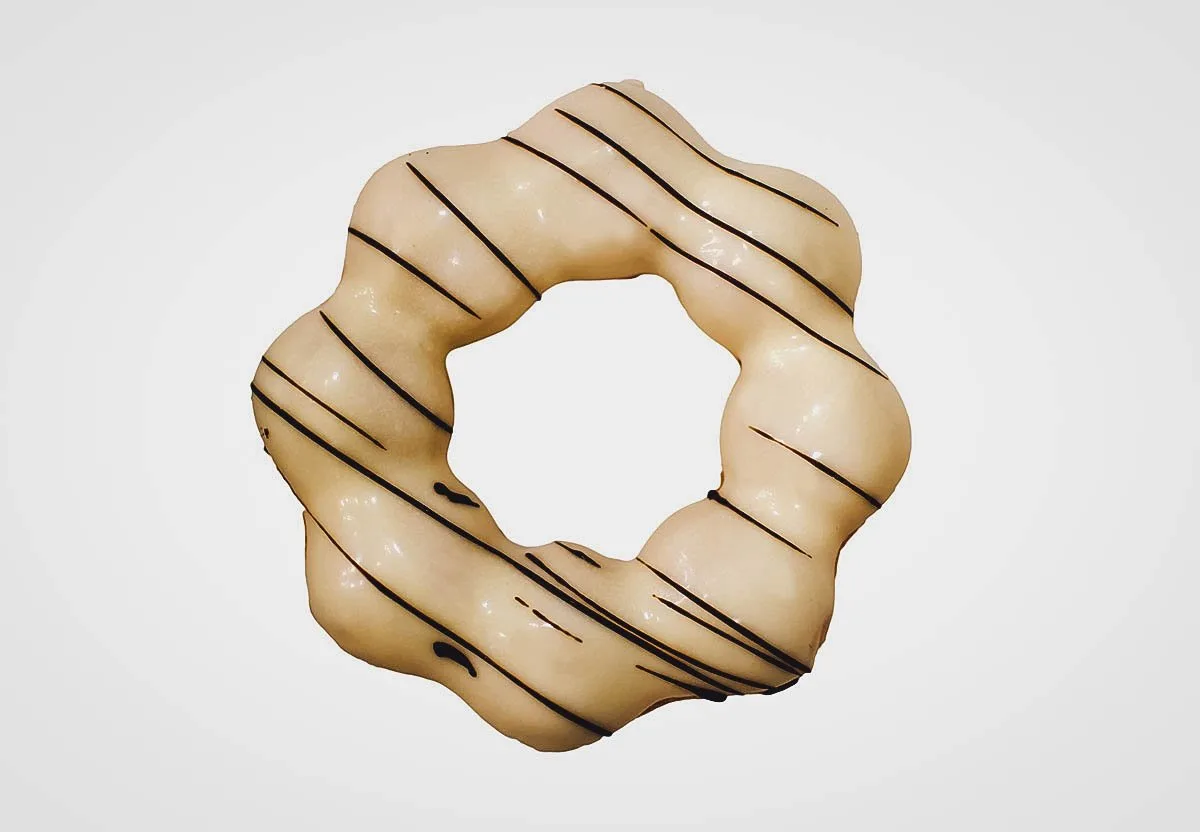
Photo by catinsyrup
Vegan Donut
A vegan donut refers to any type of donut made without animal byproducts. Soy, almond, or coconut milk is used instead of cow’s milk while eggs are substituted with a powdered egg replacer or eliminated altogether.
Careful thought is also given to the toppings and fillings. Alternate sugars (turbinado, beet, raw) are often used instead of refined sugar as the latter can sometimes be processed with animal bone char to remove impurities.
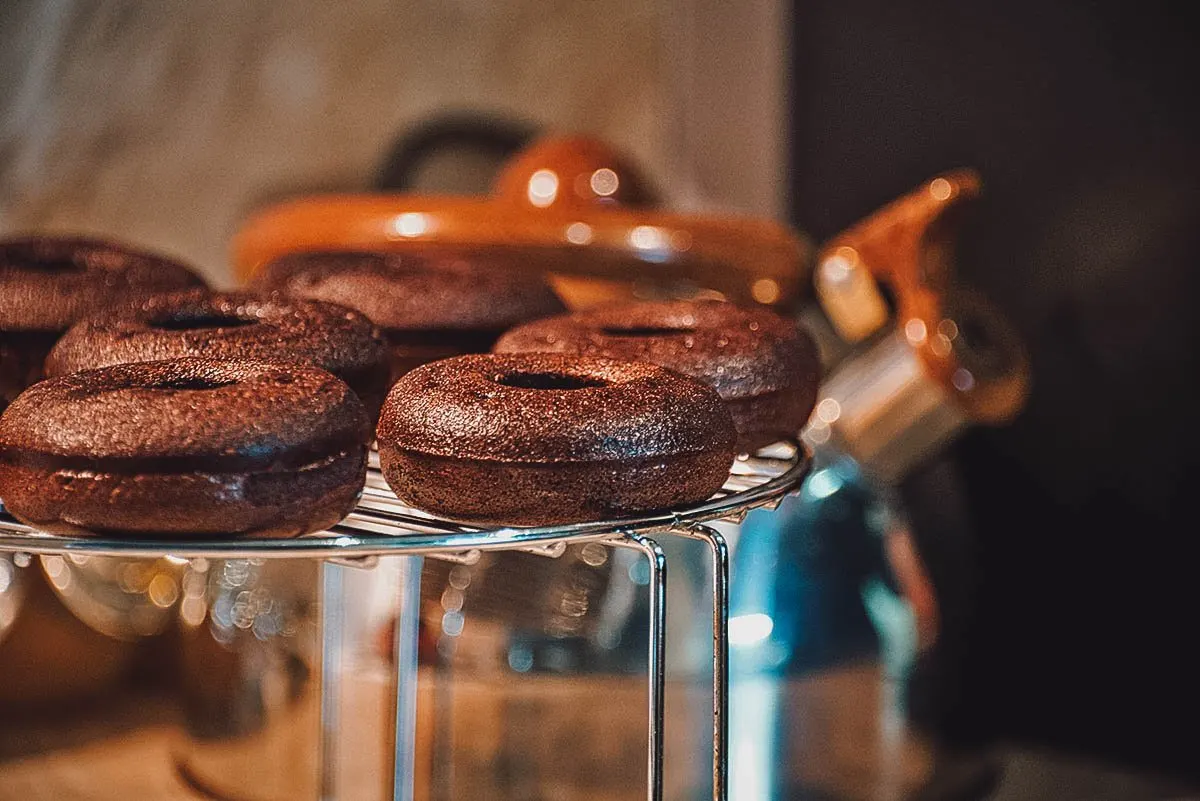
Photo by Millenn
POPULAR DONUT SHAPES
Donuts can be made in a multitude of shapes. You could twist a piece of fried dough into a unicorn and it would still be a donut.
Unicorn-shaped donuts are rare but here are some of the most common.
Ring Donuts
As described, ring-shaped donuts are usually what many of us think of when we think of donuts. They’re typically made by either joining the ends of a long piece of dough, or using a donut cutter to cut out donut shapes from a large sheet of dough.
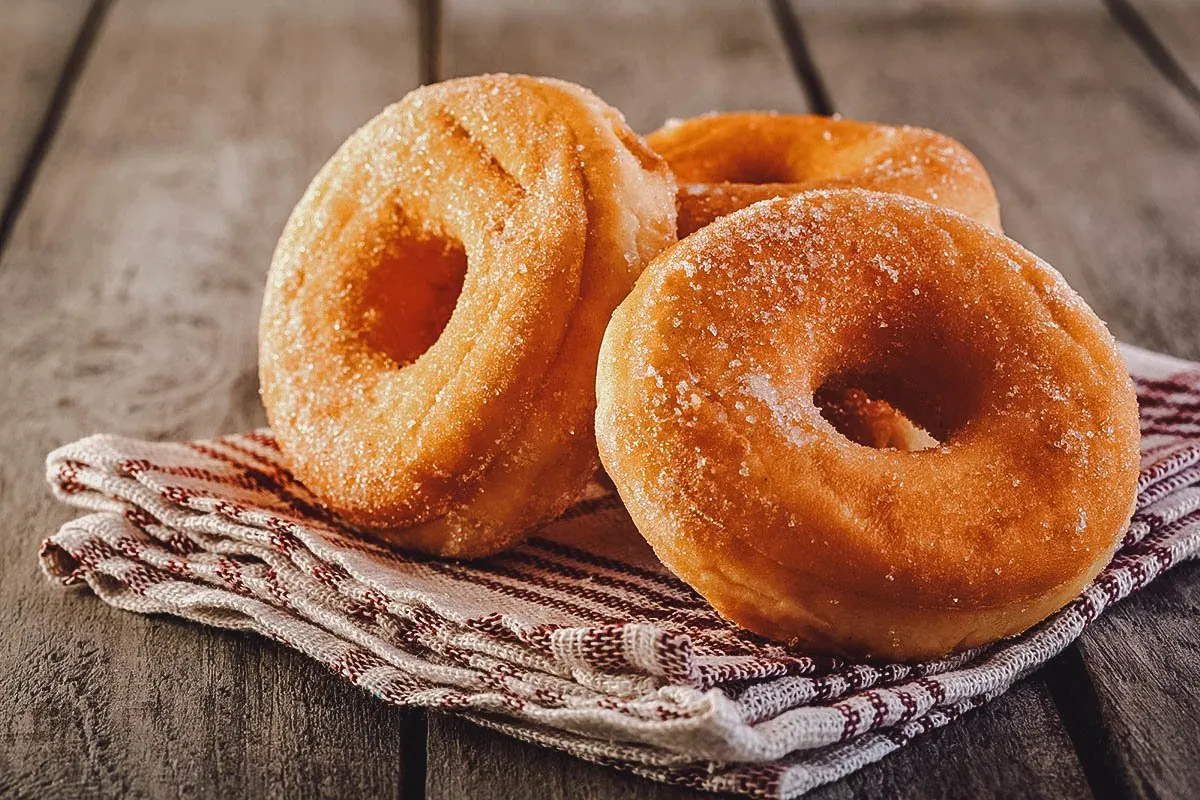
Photo by fotek
Filled Donuts
Filled donuts like jelly donuts are just as popular as ring-shaped donuts, especially in parts of Europe. They’re made by injecting fruit preserves, vanilla custard, cream, and other ingredients into hole-less spheres of fried dough.
The jelly donut is perhaps the most well-known but Bavarian cream donuts are also popular. When I walk into Dunkin donut shops, I usually make a beeline for the Bavarian.
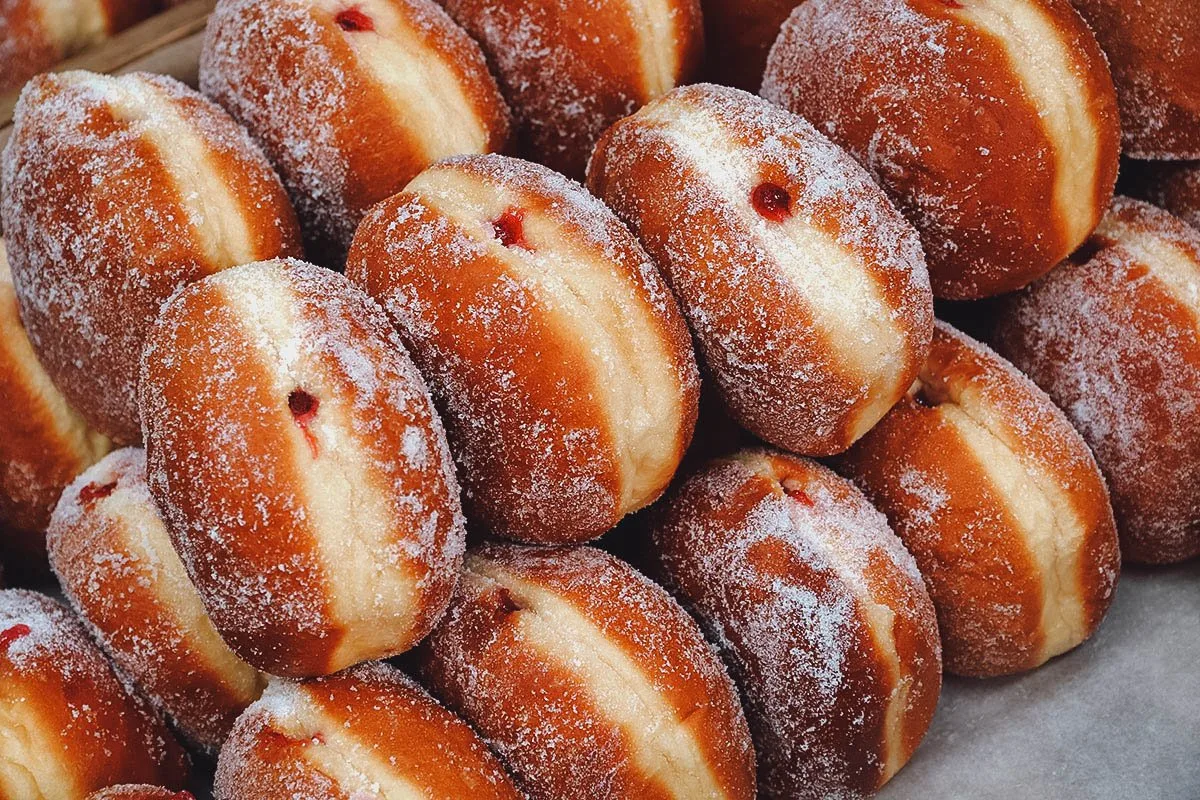
Photo by tupungato
Donut Holes
Donut holes are bite-sized spheres of fried dough cut from the center of ring donuts. Like ring or filled donuts, they can be topped with various glazes or injected with fillings like fruit preserves and custard.
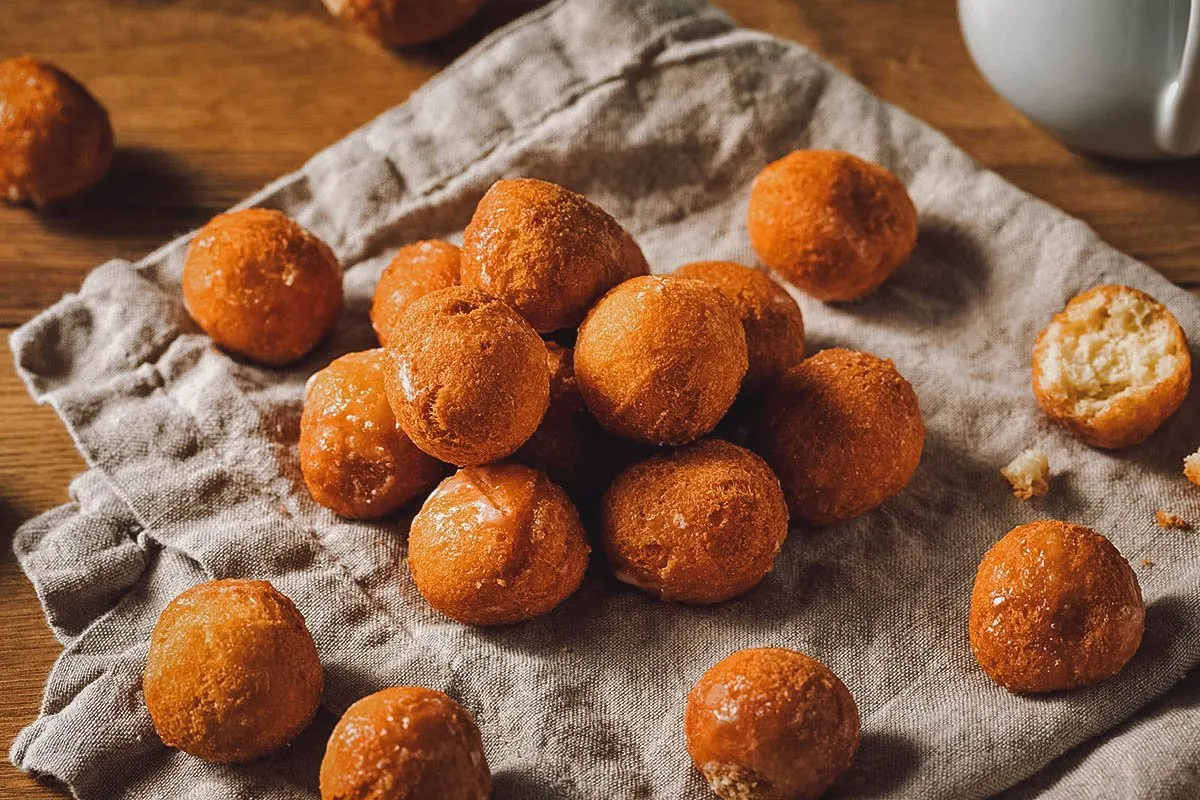
Photo by bhofack2
Drop Donuts
Drop donuts are similar to donut holes but instead of being taken from the center of ring donuts, they’re made by dropping globs of batter directly into the fryer. They tend to be more irregular in shape than donut holes.
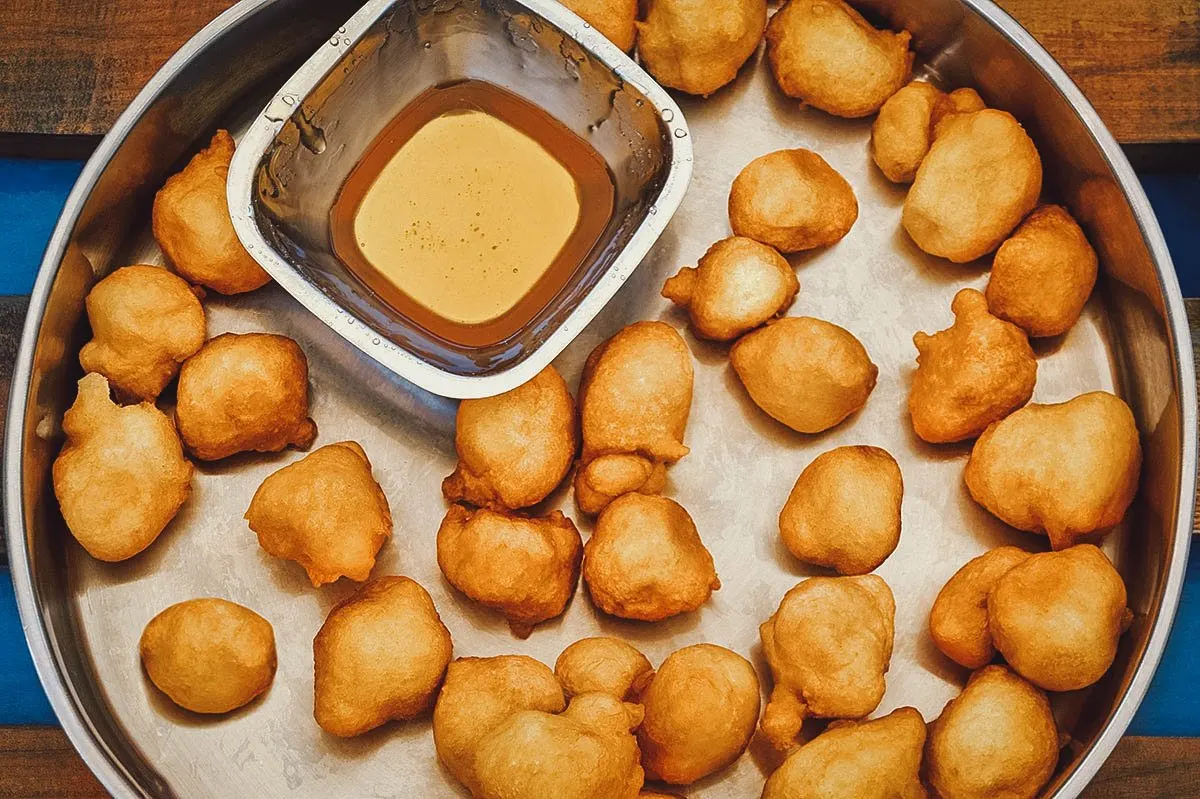
Photo by OlgaIlinich
Crullers
Crullers are donuts that look like they’ve been twisted or braided. The term cruller can refer to two types of donuts – stick-shaped cinnamon twist donuts and French crullers (pictured below). French crullers are incredibly light and airy donuts made with choux pastry piped into fluted rings.
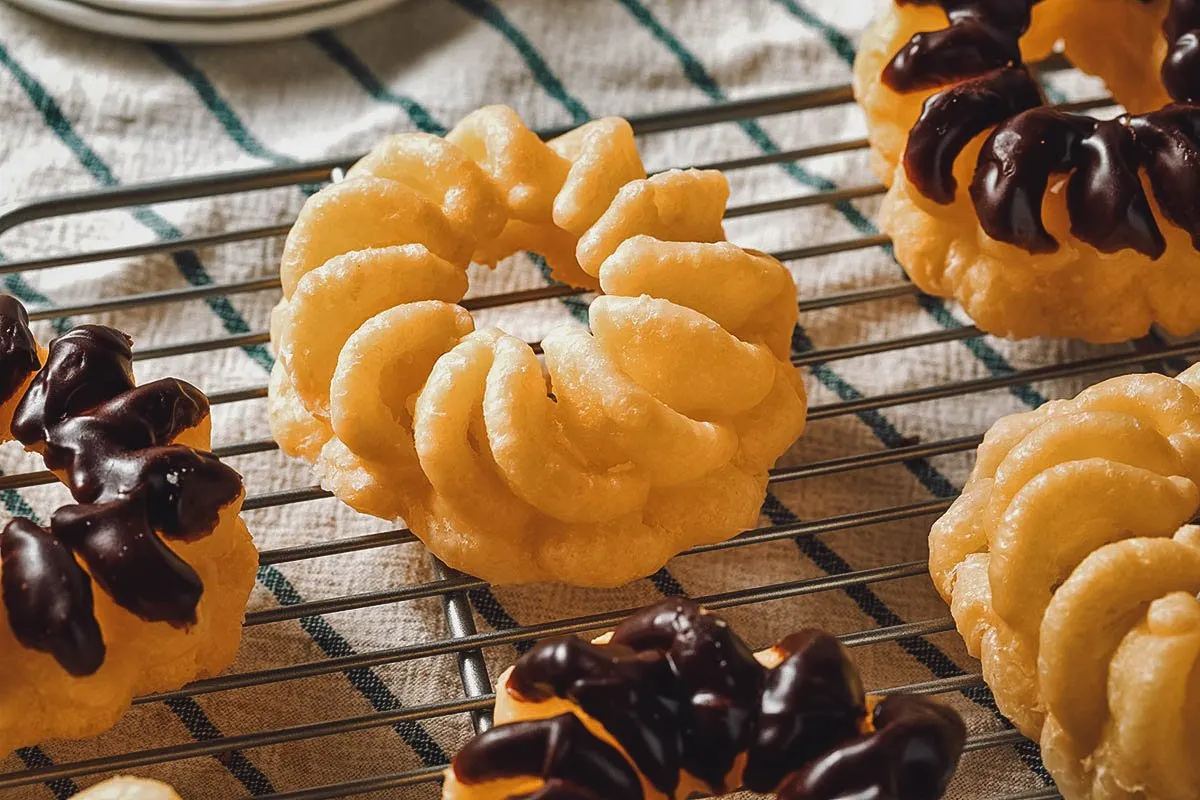
Photo by bhofack2
POPULAR DONUTS FROM AROUND THE WORLD
To make this list of donuts easier to digest, I’ve broken it down by continent. Clink on a link to jump to any section of the guide.
NORTH AMERICA
1. Glazed Donut (USA)
Two words – Krispy Kreme. This iconic American donut brand makes an amazing lineup of donuts but in my opinion, their classic glazed donut is still the best.
Glazed donuts are topped with a variety of different glazes made from a base of milk, sugar, and vanilla or cocoa powder. Other flavorings may be added to the glaze like chocolate, maple syrup, strawberry, or matcha.
Donuts are dipped into the glaze and left to cool on a rack. While still wet, they can be topped with other ingredients like candy sprinkles and sugar that bind to the glaze.
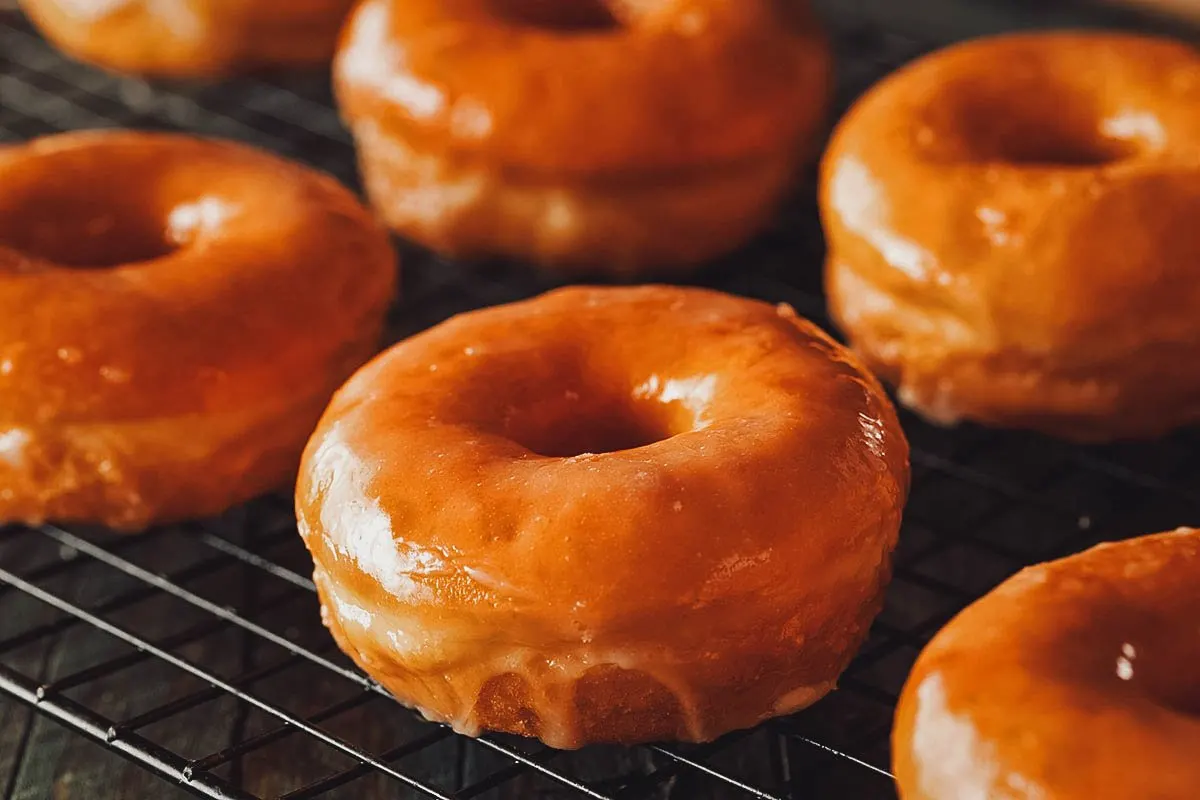
Photo by bhofack2
2. Boston Cream Donut (USA)
In many countries around the world, Dunkin Donuts is still king. Like many people, I grew up with this iconic American brand and always gravitated to three flavors – jelly donuts, Bavarian cream donuts, and Boston cream donuts.
The Boston cream donut is essentially the donut version of the Boston cream pie, a popular cake topped with chocolate glaze and filled with vanilla custard. Both desserts have become state symbols of Massachusetts.
Boston cream pie was declared the official dessert of Massachusetts in 1996 while the Boston cream donut was named the state’s official donut in 2003.
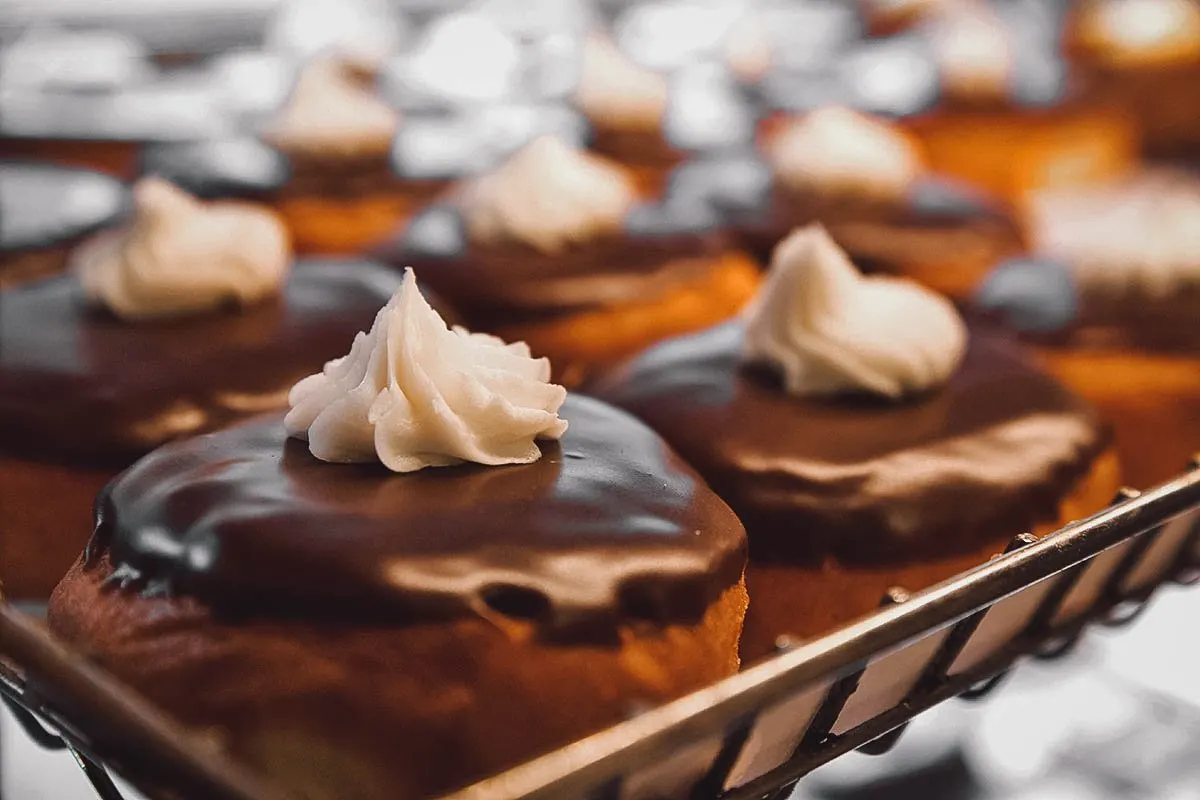
Photo by littleny
3. Sour Cream Donut
The sour cream doughnut is a type of cake donut popular mainly in the US. Also known as “old-fashioned donuts”, they’re made with sour cream incorporated into the cake batter.
The sour cream donut is known for its irregular shape and porous surface. It has a crisper texture than other cake donuts and is typically dipped in glaze or coated in powdered sugar.
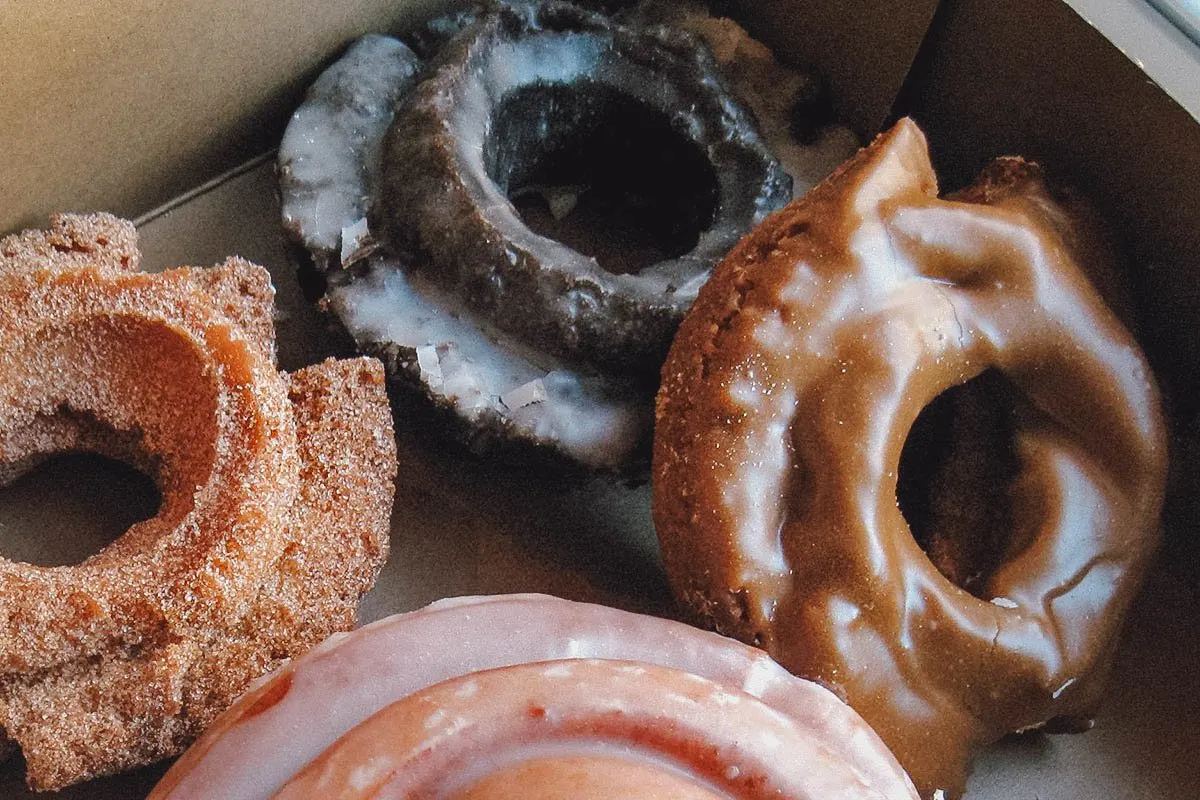
Photo by Arnold Gatilao, CC BY 2.0, via Wikimedia Commons / Processed in Photoshop and Lightroom
4. Cronut (French-American)
The cronut is a fairly recent creation that set the internet on fire not too long ago. Created by French baker Dominique Ansel, it’s an interesting croissant-donut hybrid that resembles a donut but is made with croissant-like dough. The pastries are fried in grapeseed oil and can be filled or unfilled.
The cronut debuted at Ansel’s bakery in SoHo, New York in 2013. It exploded in popularity almost immediately and was named one of the best “extremely fun” inventions of 2013 by Time magazine.
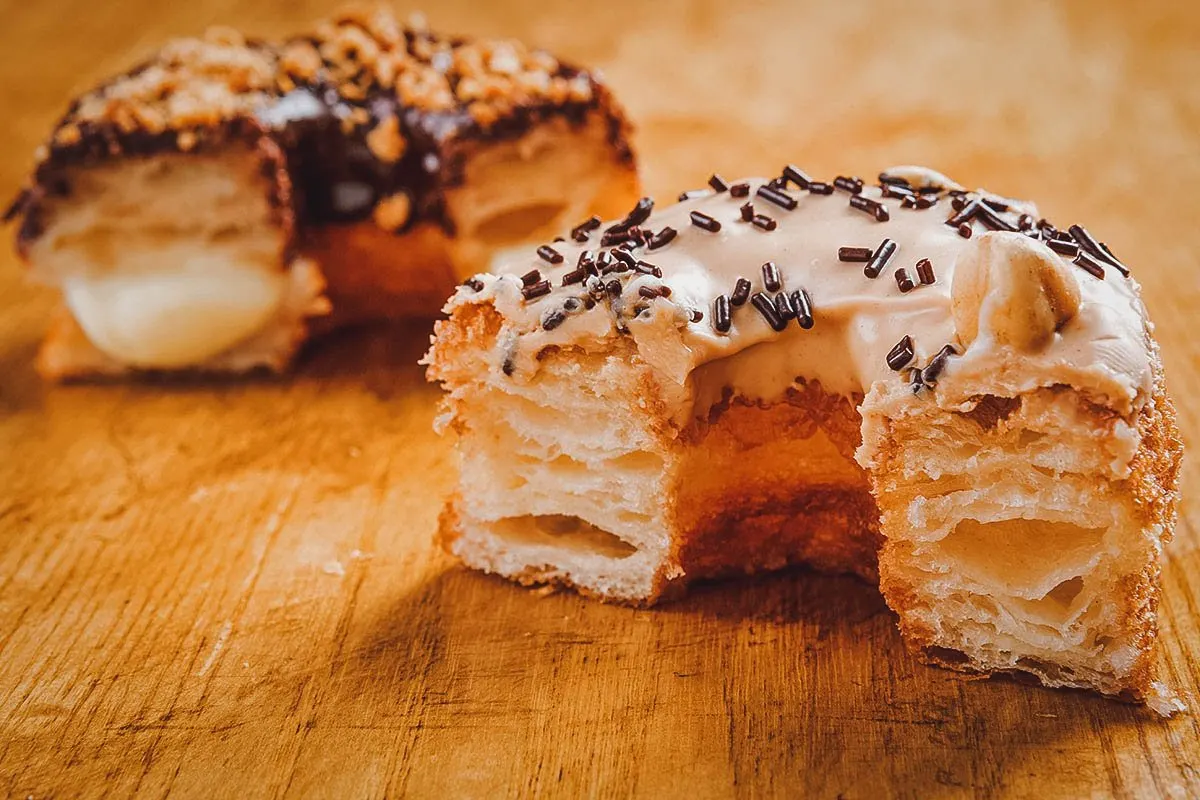
Photo by fotopitu
SOUTH AMERICA
5. Picarones (Peru)
Picarones are Peruvian doughnuts made with squash and sweet potato. Coated in chancaca syrup (molasses), they’re a popular street food snack in Peru often served with anticuchos (skewered meat dishes).
Picarones were said to have been invented during the colonial period to replace Spanish buñuelos. At the time, buñuelos were too expensive to make so people substituted some of the traditional ingredients with squash and potato to make it more accessible.
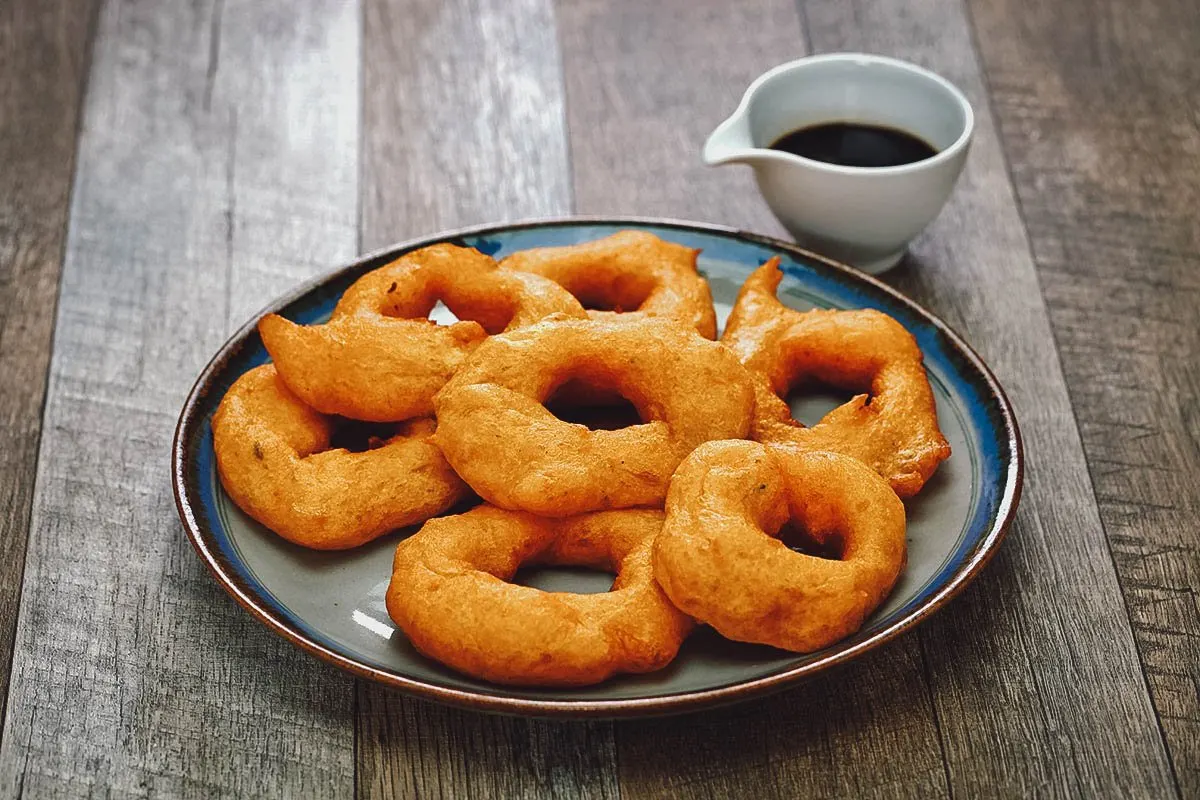
Photo by asimojet
6. Sonhos (Brazil)
The sonho is a type of filled donut popular in Brazil. It’s very similar to the German berliner (#13) except it’s typically filled with confectioner’s cream instead of the marmalade or jam favored in Germany.
Unlike the berliner and other types of filled donuts, sonhos aren’t injected with filling. They’re sliced in half and slathered with a generous amount of cream before being dusted with powdered sugar and eaten like a sandwich. In Portuguese, sonho means “dream”.
It’s unclear how sonhos arrived in Brazil. Some say it was by way of the Portuguese while others credit German immigrants for introducing this dreamy donut to Brazil.
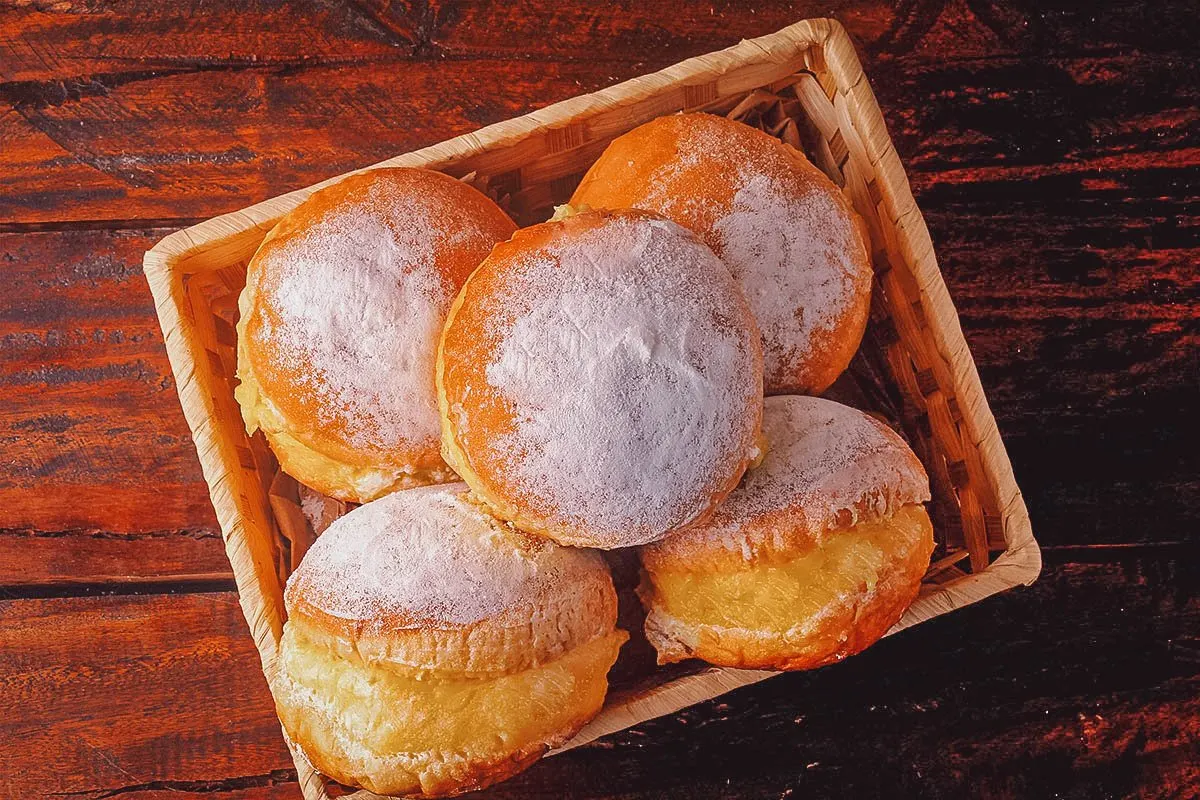
Photo by agphotography
EUROPE
7. Churros (Spain)
If you’ve been a long-time fan of churros but have never thought of them as a type of donut, then you’re not alone. Churros are one of the most popular Spanish desserts but due to their shape, many people don’t think of them as donuts, but they absolutely are.
Churros are deep-fried pastries that are typically eaten for breakfast or as a snack with hot chocolate or cafe con leche. They have a ridged surface and can be straight, curled, or spiral in shape.
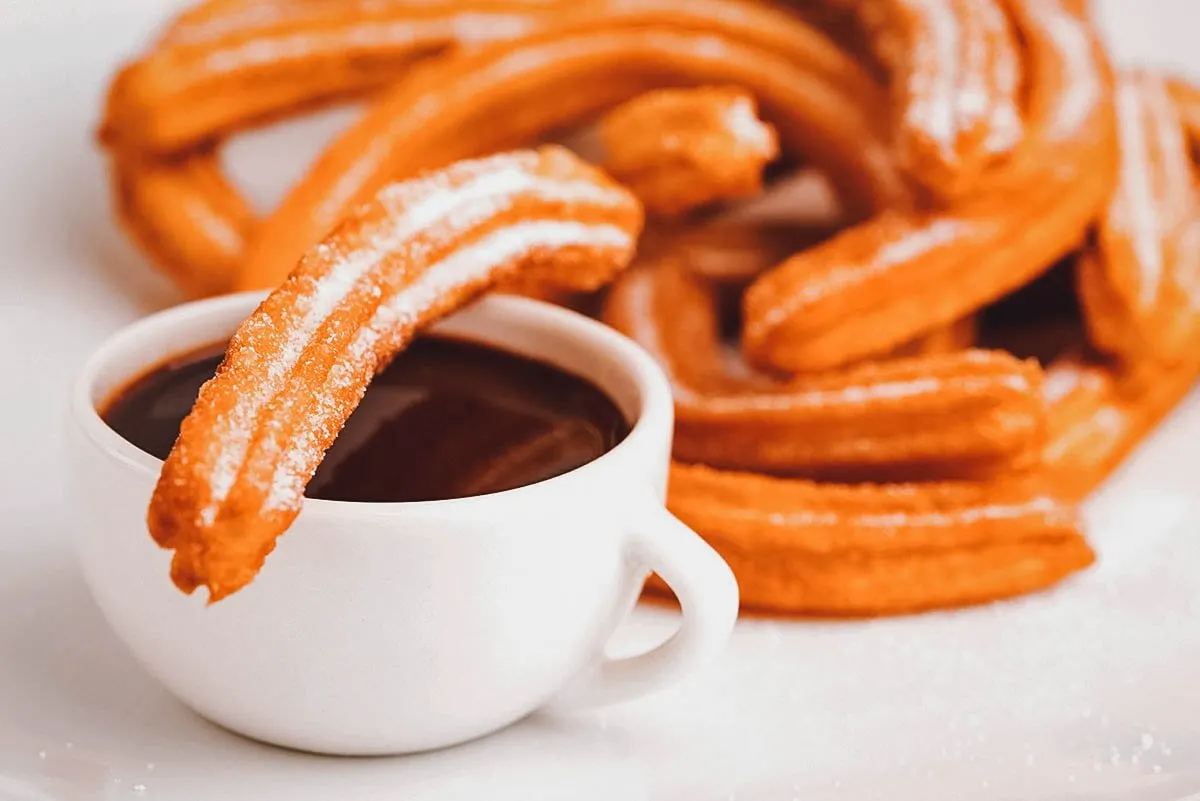
Photo by joannawnuk
Churros are equally popular in former Spanish colonies. In Spain, they’re typically served plain but in other countries like Mexico, they’re often dusted with cinnamon sugar. They can also be stuffed with various fillings like chocolate, cajeta (dulce de leche), or rompope (Mexican eggnog).
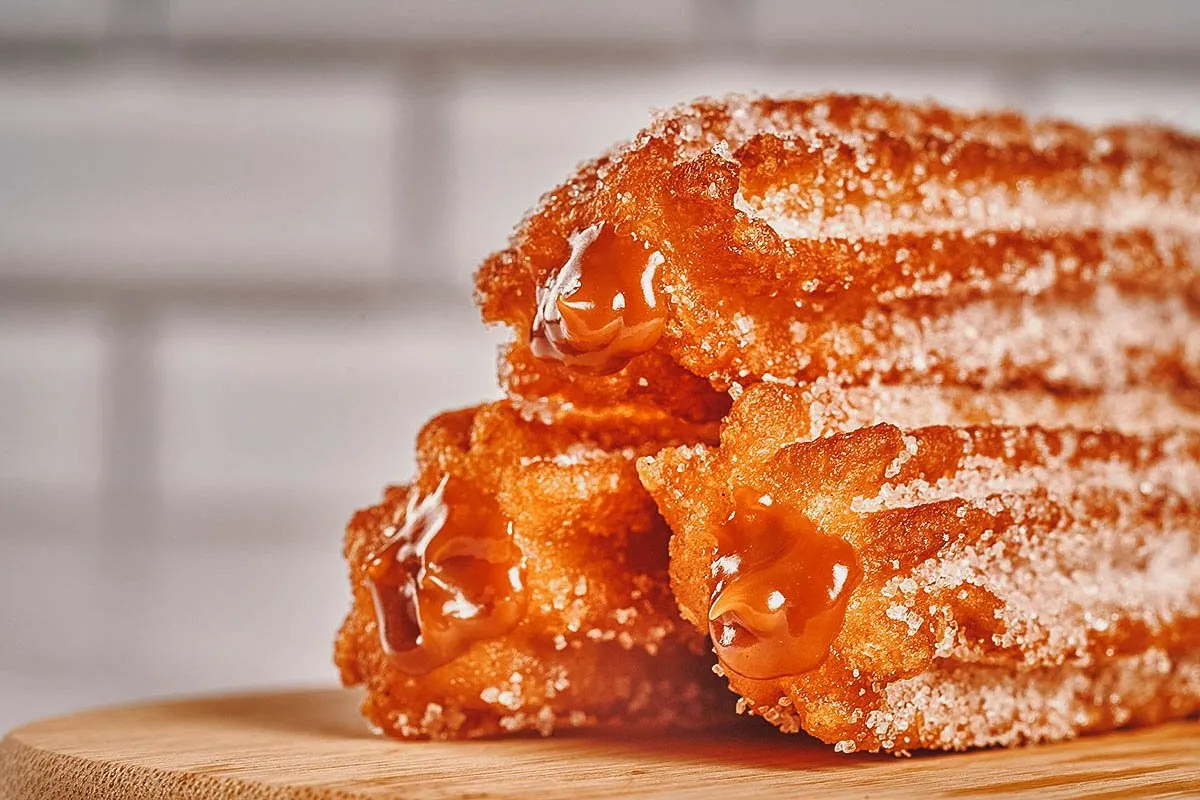
Photo by gabrielpazph
8. Rosquillas (Spain)
Rosquillas are another type of donut popular in Spain. They’re very similar to churros except they’re shaped like rings.
Smaller than American donuts, rosquillas are typically served dusted with powdered sugar or dipped in a chocolate glaze.
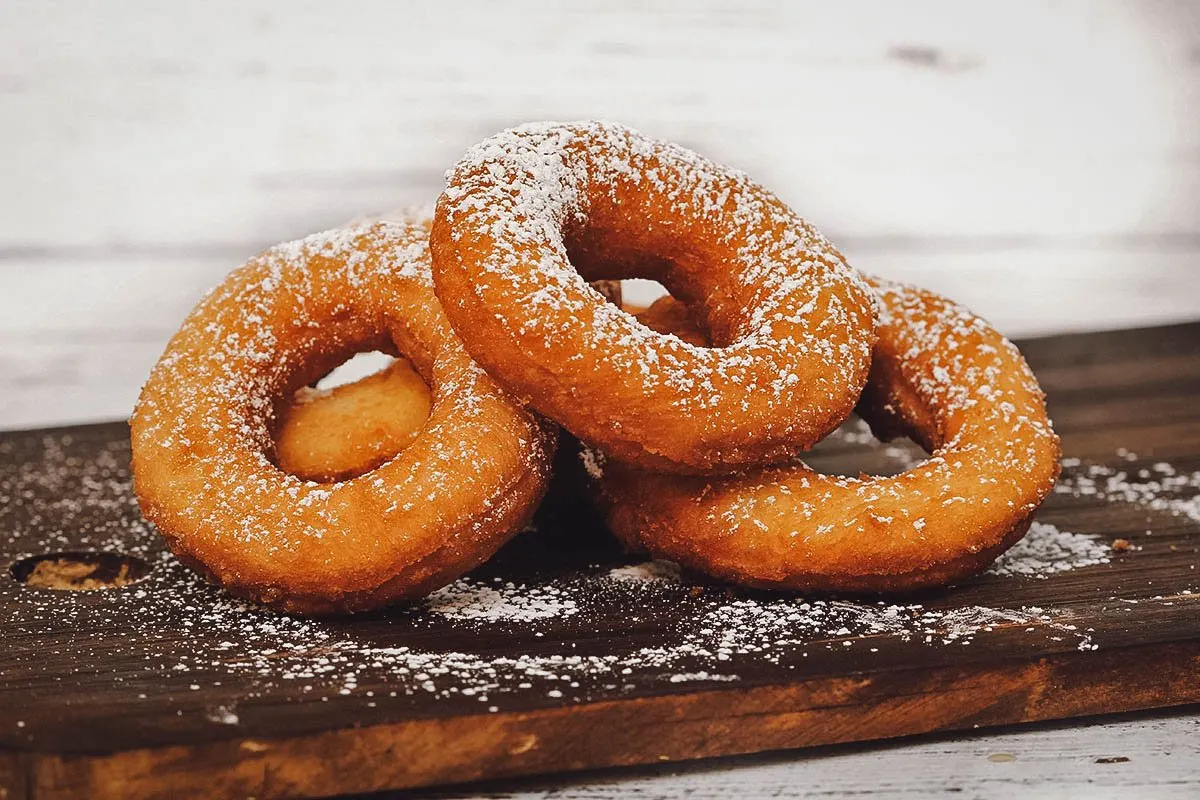
Photo by alga38
9. Malasadas (Portugal)
If you’ve been to Hawaii, then you may be familiar with malasadas. They’re a type of Portuguese yeast donut flavored with lemon zest and coated with cinnamon sugar. Portuguese malasadas are typically hole-less and served without a filling, but Hawaiian versions usually contain some type of filling like custard, chocolate, coconut, or guava.
Malasadas were introduced to Hawaii by Portuguese laborers who arrived in the late 19th century to work in the plantations. They brought some of their traditional Portuguese foods with them, including malasadas, which would later become integrated into local Hawaiian cuisine.
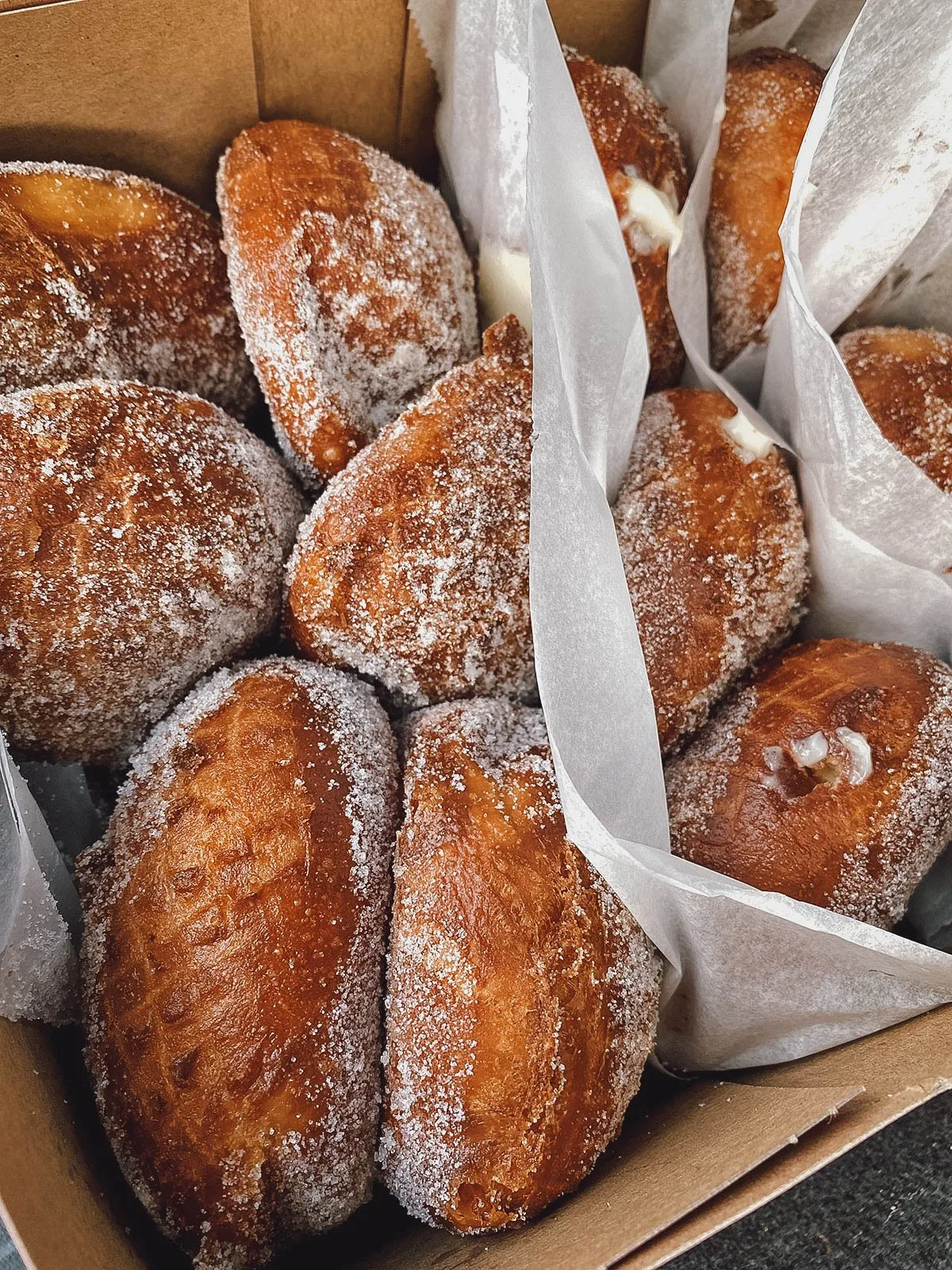
Photo by Wirestock
10. Zeppole (Italy)
Zeppole are small Italian donuts that are typically prepared to celebrate St. Joseph’s Day. Like French crullers, they’re made with light and airy choux pastry dough that can be dropped into the fryer using a teaspoon or piped in using a funnel.
Zeppole are usually dusted with powdered sugar and can be filled with various ingredients like custard, jelly, and pastry cream. Like sonhos, they’re sliced in half and slathered with filling with an extra helping piped in through the top.
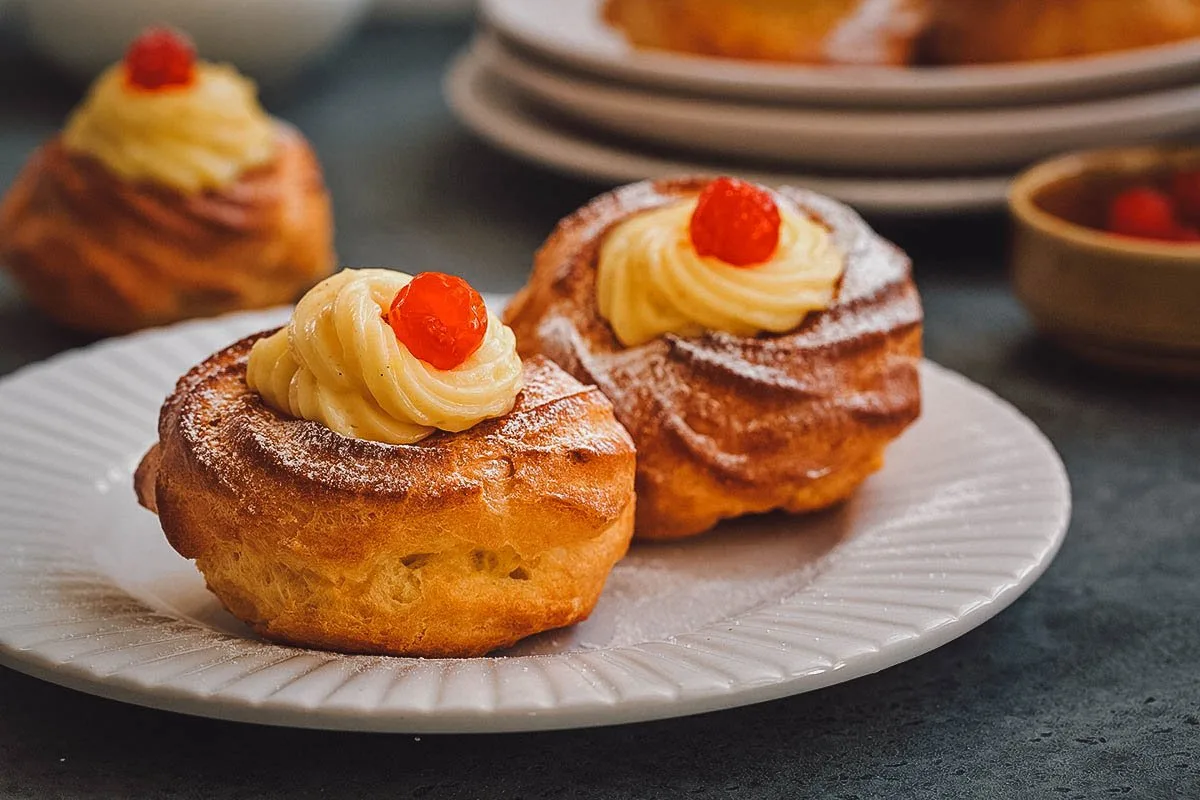
Photo by OlgaBombologna
11. Bomboloni (Italy)
Just saying this donut’s name is making me gesture in the Italian way. “Bomboloni!”
Traditionally associated with Tuscany, bomboloni are Italian yeasted doughnuts rolled in sugar and filled with pastry cream (crema pasticciera). Bombolone is derived from the word bomba, meaning “bomb”, and is perhaps in reference to the round, bomb-like shape of the donut.
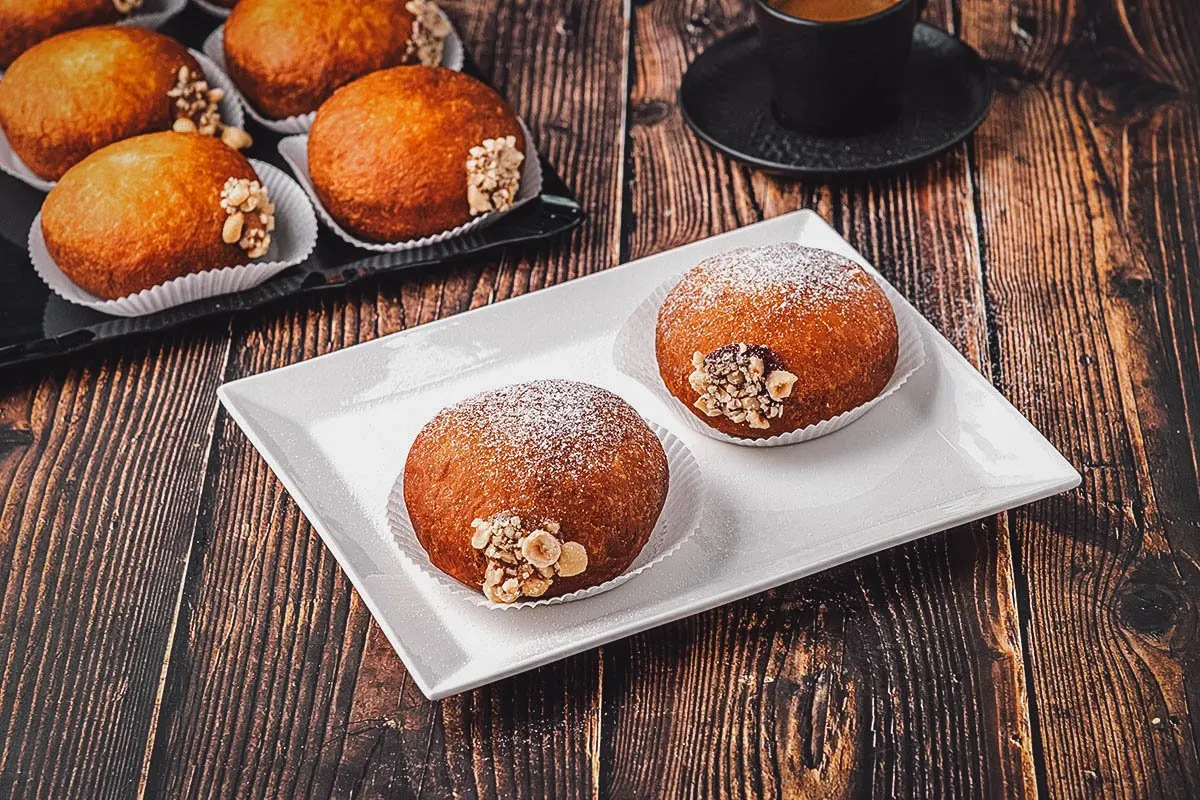
Photo by yalcinsonat1
12. Beignet (France)
The beignet is a type of donut popular in French and French-American cuisines. They’re traditionally made with choux pastry though they can be made with other types of dough as well.
Depending on where you’re from, you may know beignets as these square pastries heavily dusted with powdered sugar. Popular in New Orleans, this type of beignet is made with leavened dough instead of choux pastry. They’re commonly eaten for breakfast or dessert, usually with some hot chocolate or cafe au lait.
Beignets are said to have been brought to the US by French settlers who first moved to the Acadia region of Canada in the 17th century. Many Acadians would later move to Louisiana and bring the beignet with them.
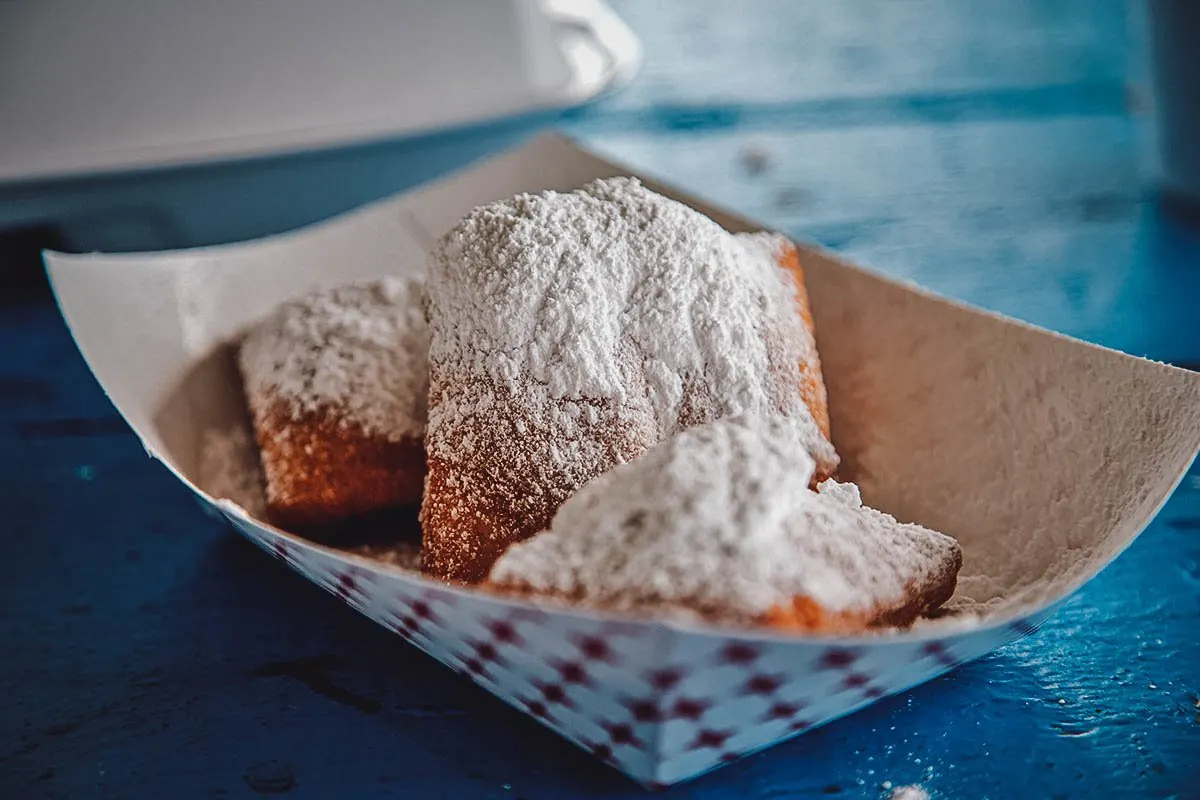
Photo by katkami
Beignets are typically made from choux pastry though it isn’t uncommon to find more cake-like beignets in France. Round or oval in shape, they’re often referred to as “boules de Berlin” because they’re made with a similar dough as German berliners.
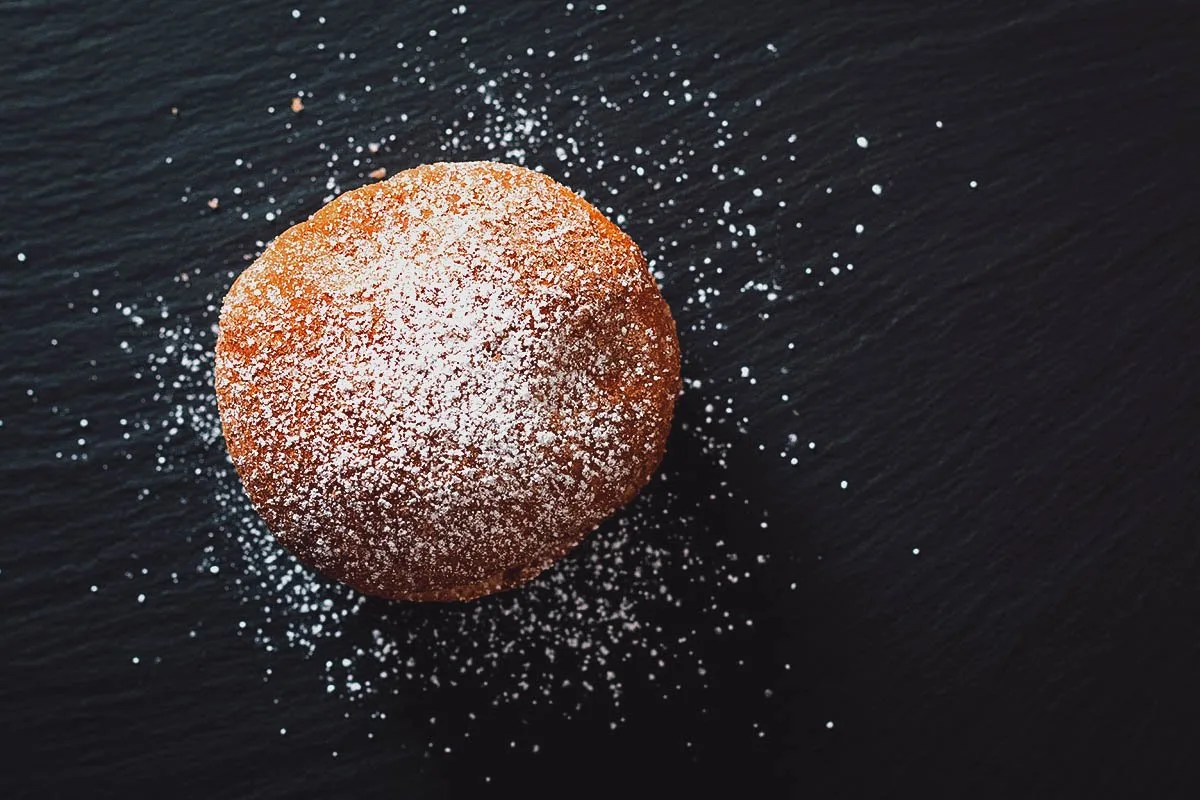
Photo by [email protected]
13. Berliner (Germany)
The berliner is a popular type of filled donut from Germany. It’s made from yeast dough fried in fat or oil and injected with a jam or marmalade filling. It’s basically the German version of a jelly donut.
Berliners were traditionally made to usher in the New Year or to celebrate carnival holidays, but they’re now widely available throughout the year.
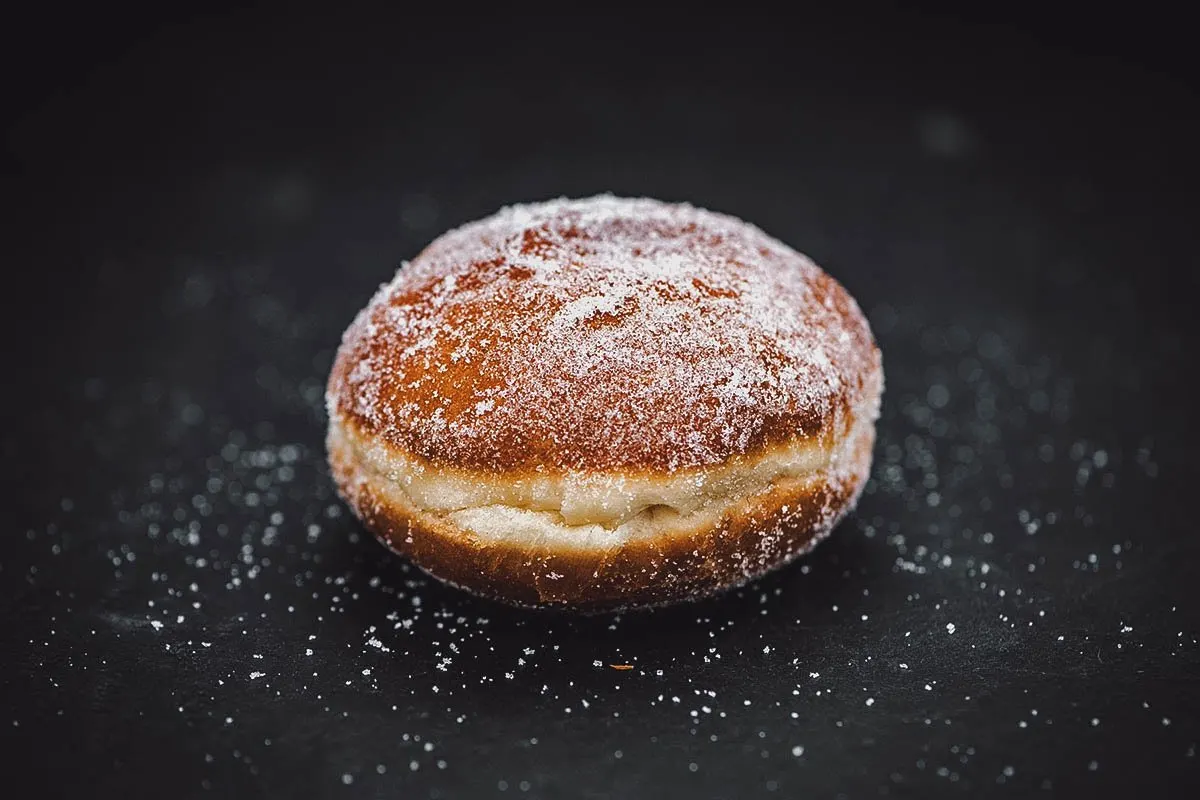
Photo by HandmadePicture
14. Oliebollen (The Netherlands)
Oliebollen are Dutch and Belgian versions of the beignet. It’s a type of drop donut made with yeasted dough, raisins, currants, and other dried fruits. Traditionally eaten to usher in the new year, they’re light and fluffy donuts drizzled with a generous amount of icing sugar.
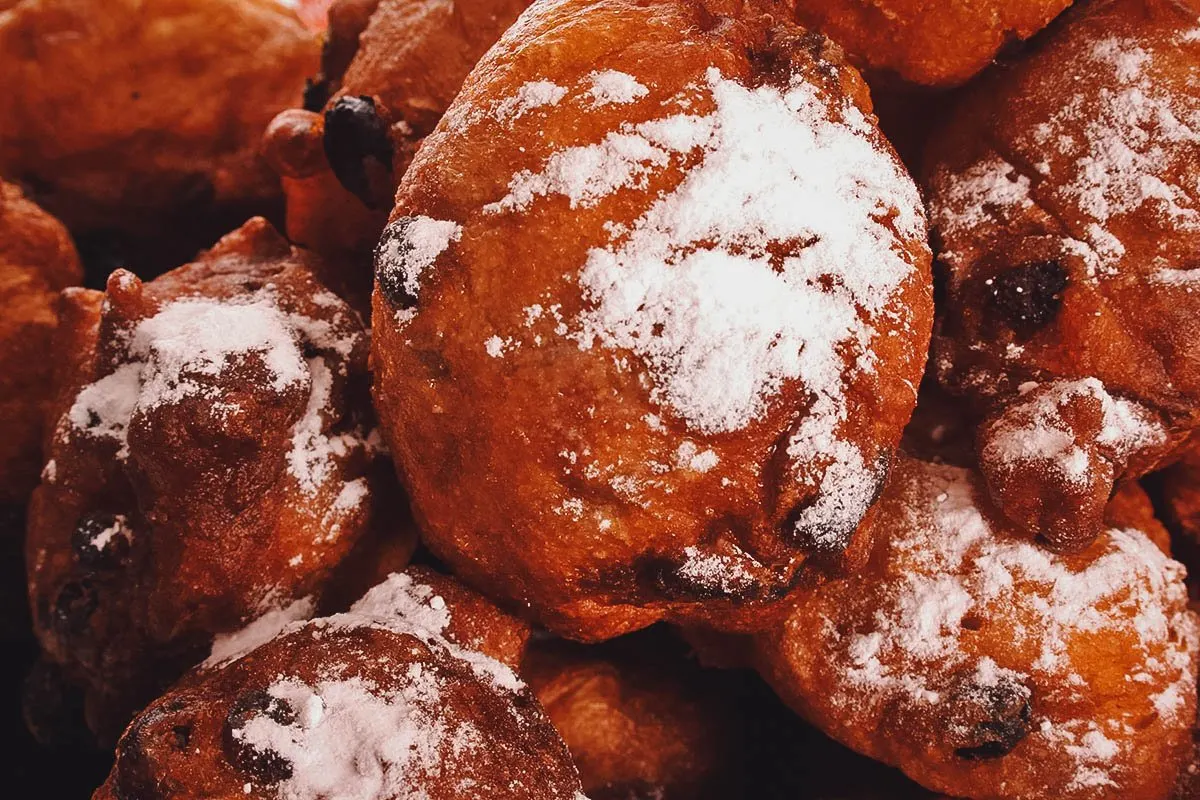
Photo by joophoek
15. Loukoumades (Greece)
Loukoumades refers to another type of drop donut, this time from Greece. They’re commonly shaped into balls though they can be made into rings as well. These light and fluffy donuts are equally popular in Turkey and in the Arab world, where they’re known as lokma and luqaimat respectively.
Loukoumades are a popular street food in Greece where they’re often served with honey, cinnamon, and finely chopped walnuts.
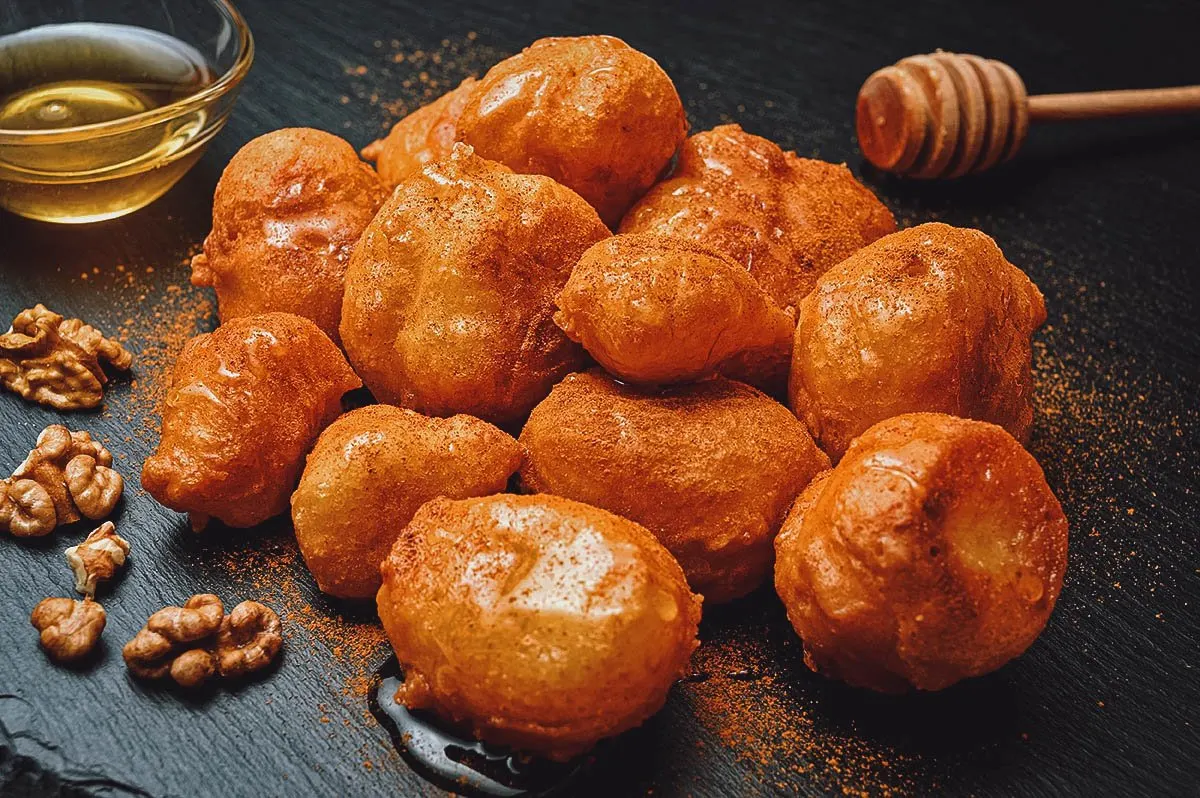
Photo by dinosmichail
16. Krafne (The Balkans)
Krafne is basically the Balkan version of the German berliner. Depending on which country it’s from, it can be referred to in slightly different names like krofne (Croatia, Albania) or krofi (Macedonia).
Like berliners, krafne are typically filled with jam or marmalade.
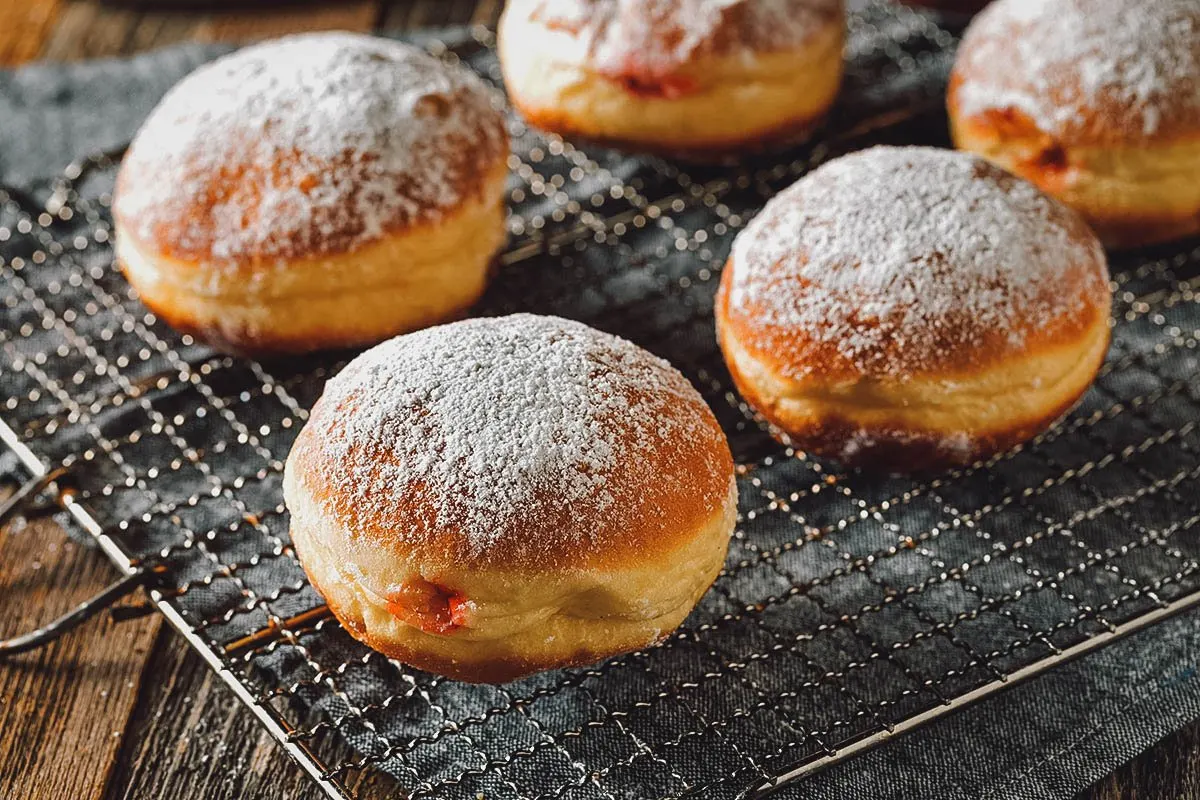
Photo by bhofack2
17. Farsangi Fank (Hungary)
Farsangi fank are light and airy Hungarian donuts. Meaning “carnival donuts”, they’re typically made to celebrate the Carnival season in Hungary – a 6-day celebration that ends on the day before Ash Wednesday.
Farsangi fank are yeasted donuts lightly seasoned with rum and lemon zest. They aren’t injected with filling but they’re often served with a dollop of jam, usually apricot or raspberry, spooned into an indentation made on the top of the donut.
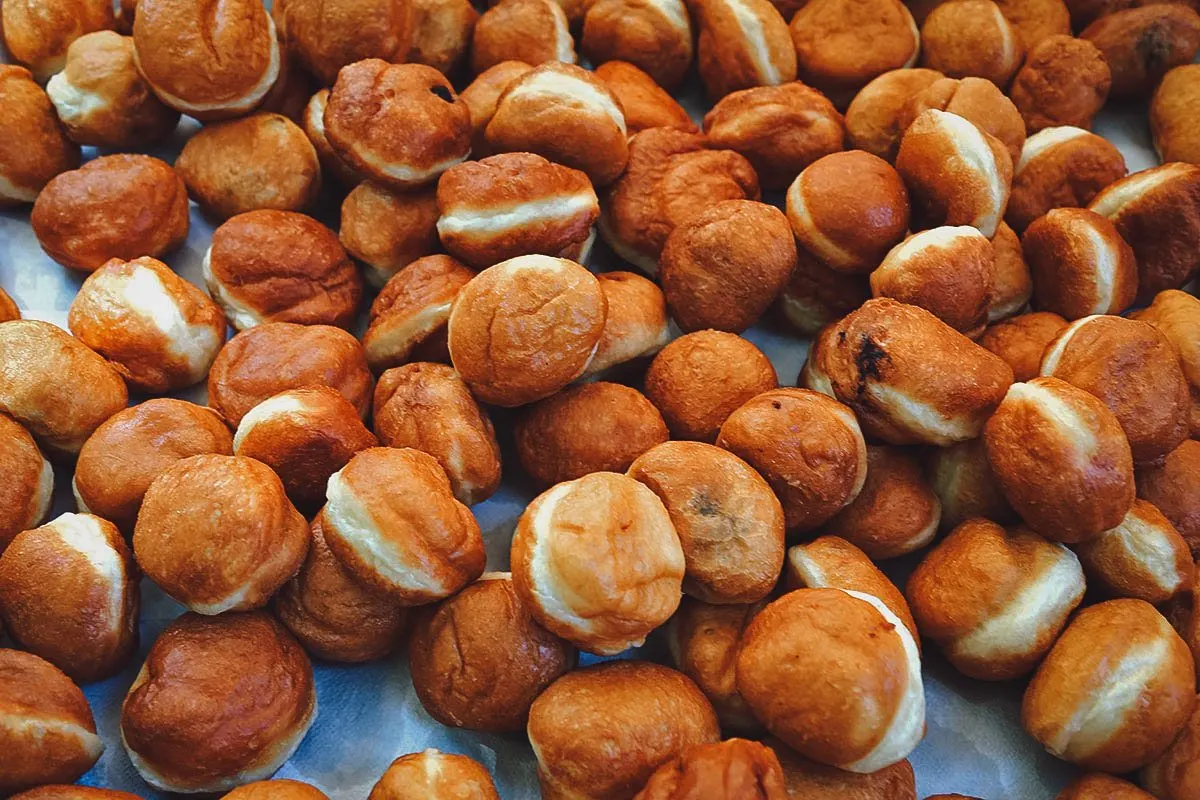
Photo by accept001
18. Spurgos (Lithuania)
Spurgos are light and airy Lithuanian donuts made with curd cheese (quark). Shaped into small round balls, they aren’t made with yeast but instead get their lift from a combination of whisked egg and baking powder.
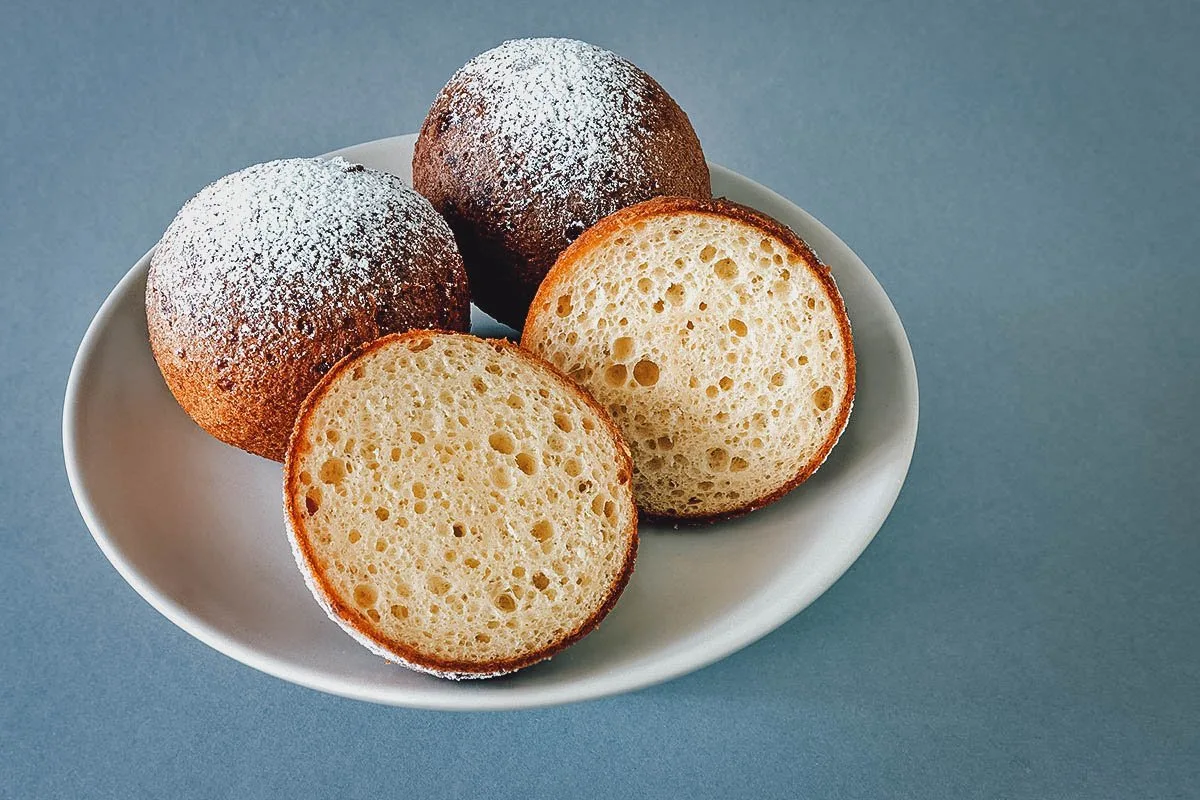
Photo by fotosenukas
19. Paczki (Poland)
Paczki refers to a type of filled donut from Poland. They resemble German berliners though they’re made using a richer dough containing eggs, fat, yeast, sugar, and sometimes milk.
Polish donuts are injected with different types of fruit preserves and other sweet fillings before being coated in a glaze or dusted with powdered sugar. It’s also common to find them topped with small bits of dried orange zest.
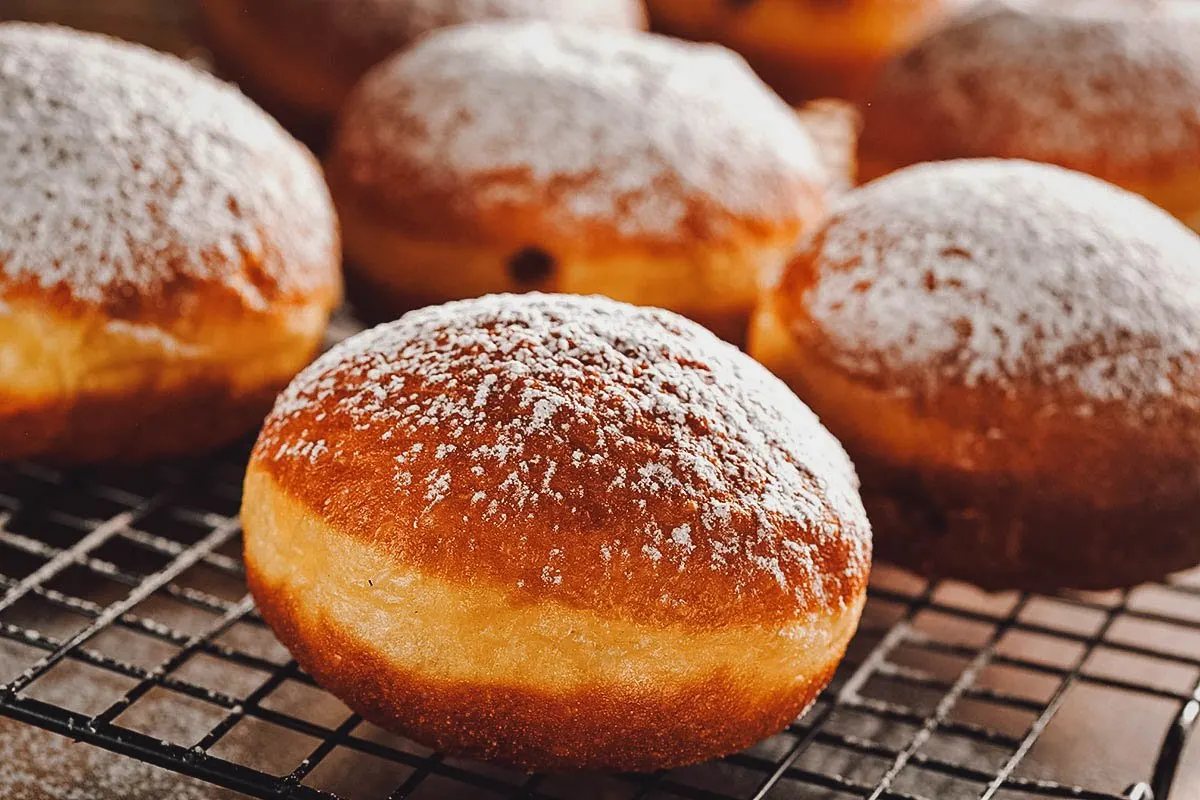
Photo by bhofack2
20. Ponchiki (Russia)
Ponchiki are basically Russian donut holes made with farmer’s cheese and very little flour. Crispy on the outside, the cheese in the recipe results in a soft, slightly moist interior with little pockets of curd cheese flavor.
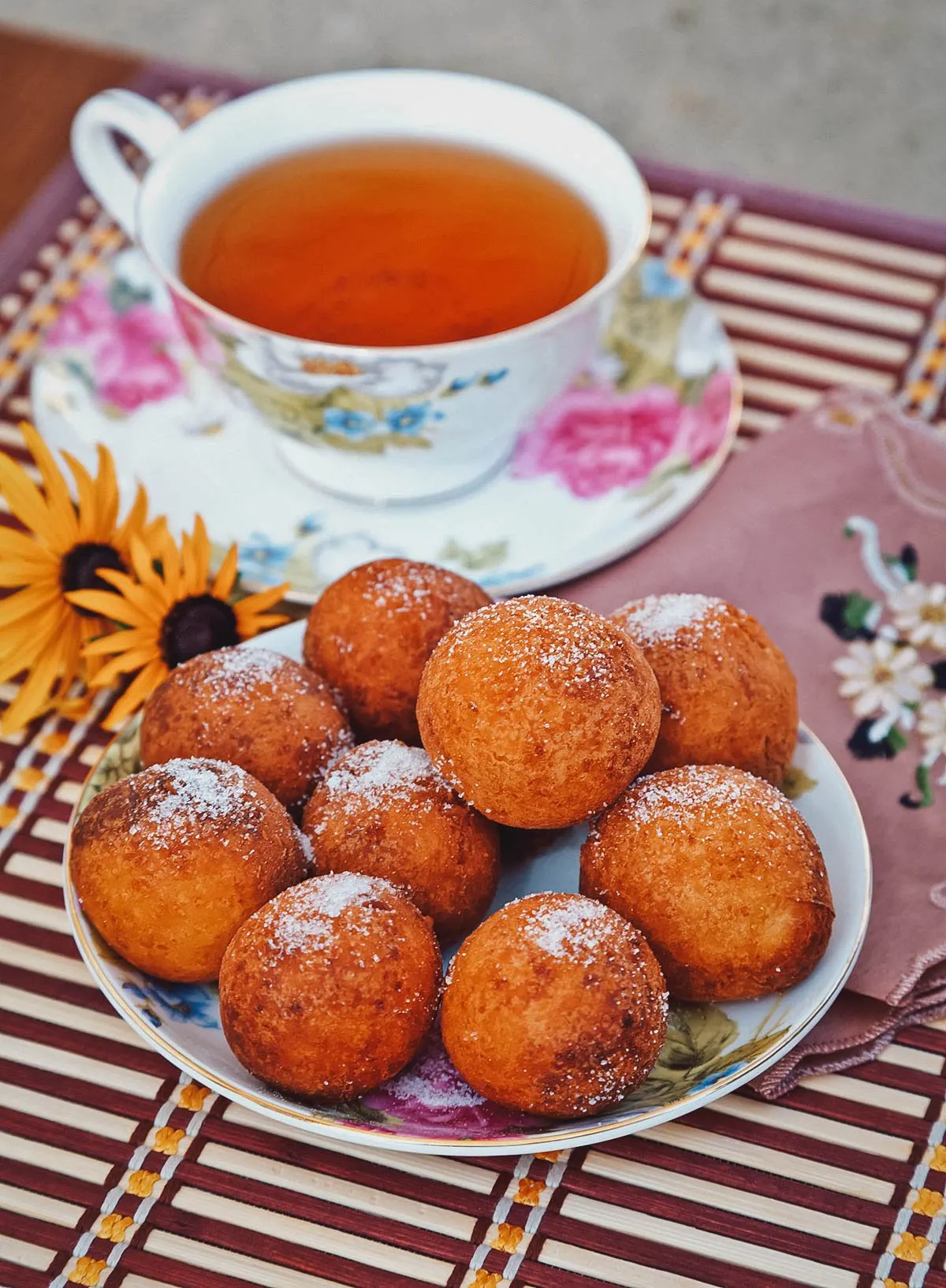
Photo by alisafarov
21. Pampushky (Ukraine)
As described at the top of this article, a piece of fried dough doesn’t have to be sweet to be considered a donut. The pampushka – a Ukrainian donut that can be savory or sweet – is an example of that.
Pampushky are small yeast donuts that can be made from wheat, rye, or buckwheat flour. They’re traditionally baked but they can also be fried.
Savory pampushky are usually seasoned with garlic sauce and served as a side dish to Ukrainian dishes like borscht. When made into a dessert, it’s often filled with fruit preserves and dusted with powdered sugar.
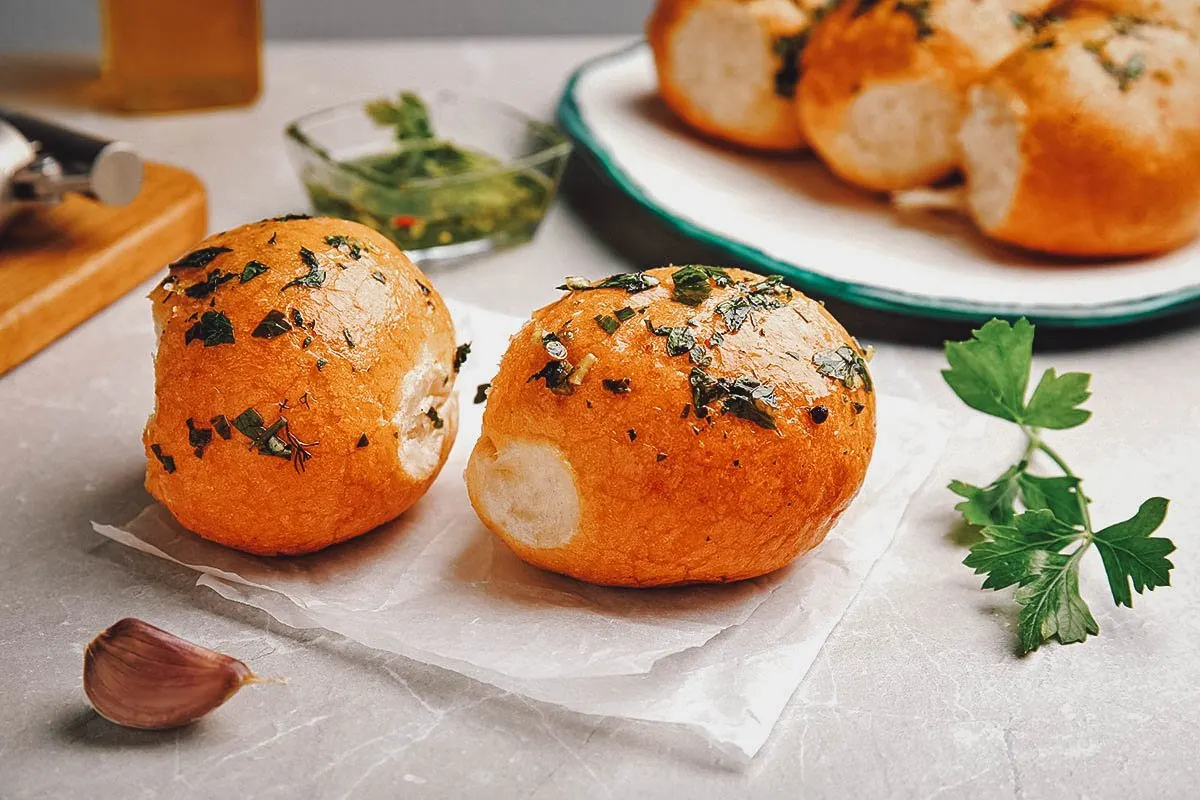
Photo by NewAfrica
ASIA
22. Matcha (Japan)
If you ever visit Kyoto in Japan, one ingredient you’ll be seeing a lot of is matcha. It refers to the finely ground powder made from processed green tea leaves.
Matcha is an integral part of Japanese tea culture but it’s also used as an ingredient in a plethora of Japanese dishes like cakes, candies, pastries, and my personal favorite – soft cream (soft serve ice cream).
Being a versatile ingredient, it can be used as a flavoring for donut glazes and toppings as well.
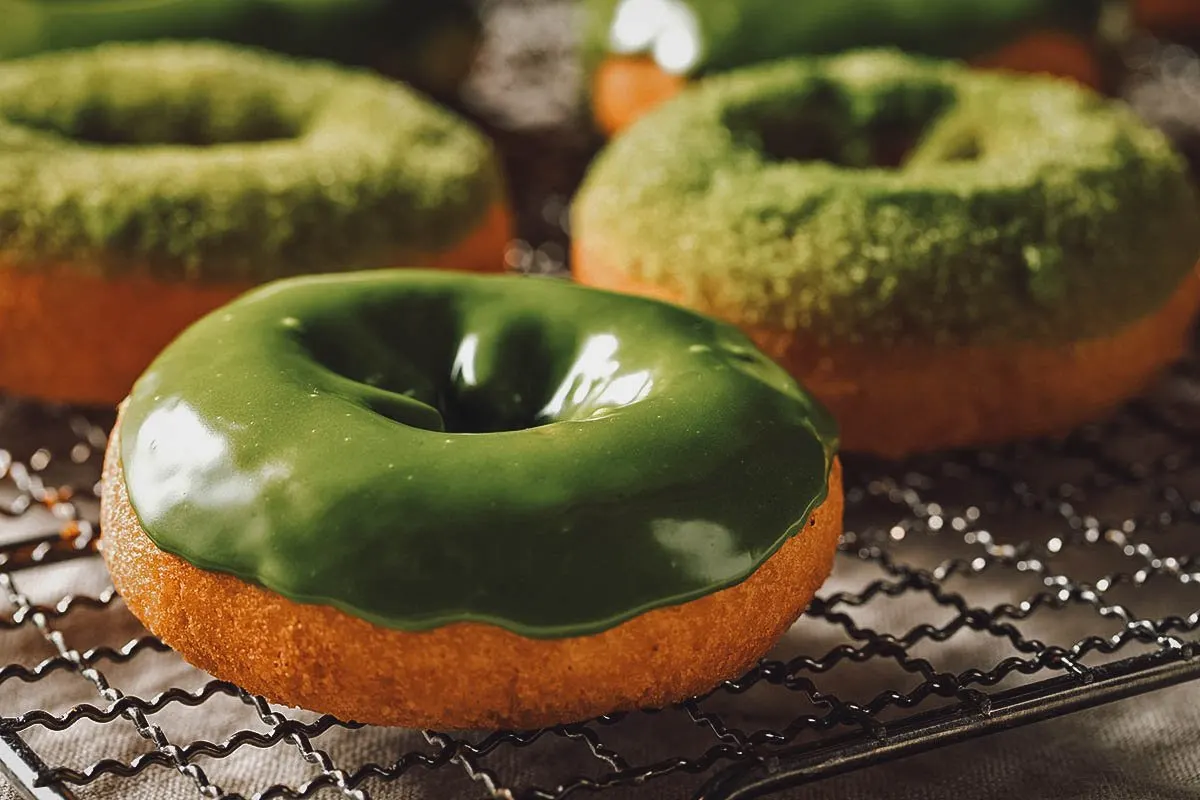
Photo by bhofack2
23. Sata Andagi (Japan)
Sata andagi are drop donuts from Okinawa. They’re native to southern China but they’ve become a staple in Okinawan and Hawaiian cuisines.
Sata andagi are made with a batter consisting of flour, eggs, and sugar mixed into ping-pong-sized balls and then deep-fried. They have a crisp crust and a moist cake-like interior that’s closer in texture to cake donuts than yeast donuts.
In Okinawan, saataa means “sugar” while andaagii means “deep-fried”.
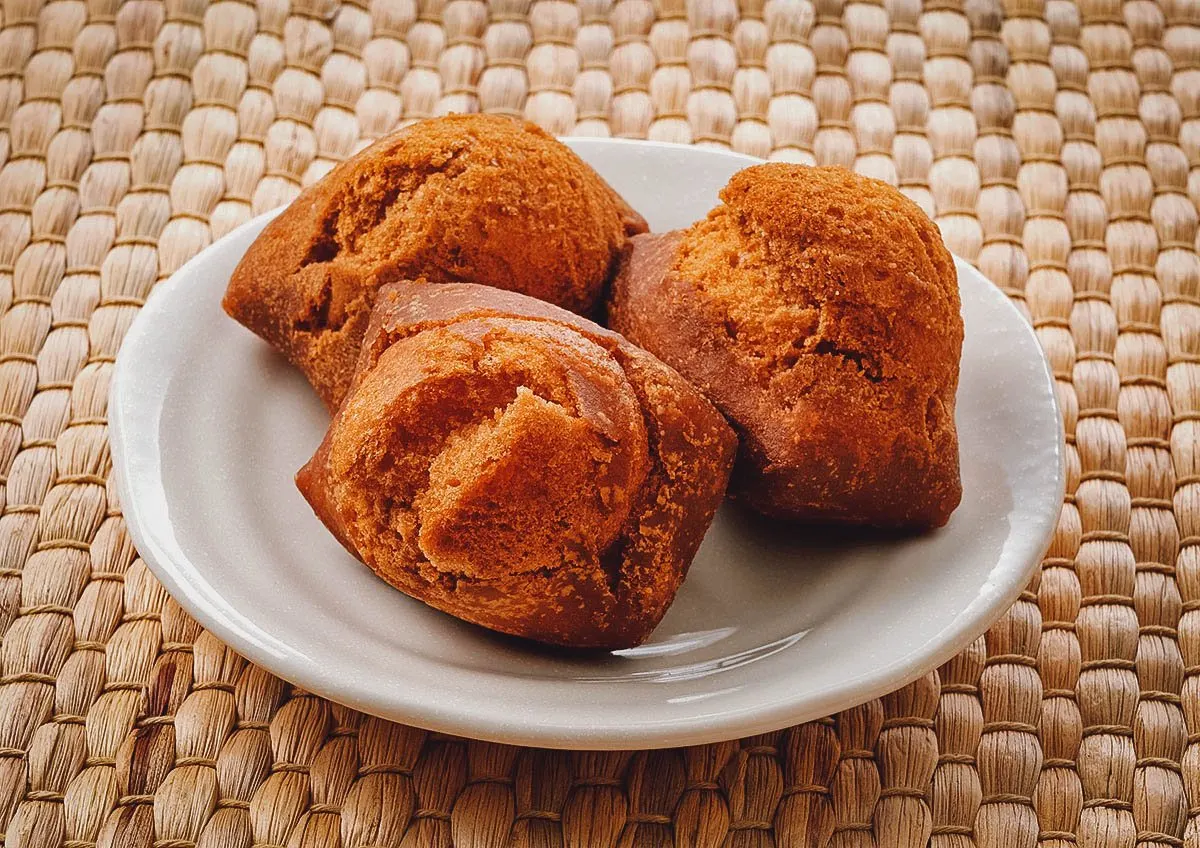
Photo by sai0112
24. Mochi (Japan)
Mochi donuts are among my favorite types of donuts. They have a chewy, mochi-like texture that’s unlike any other type of donut.
As described, mochi donuts are a type of Japanese donut made with either mochi flour or tapioca starch. They were initially popularized by the Japanese donut chain Mister Donut under the brand name “Pon de Ring”. They consist of eight little balls connected together to form a ring.
I had always assumed that mochi donuts were invented by Mister Donut but as it turns out, they may have been invented in Hawaii as a fusion of mashed taro and rice cake. I haven’t tried the Hawaiian version of a mochi donut but based on what I’ve read, it’s quite different from Pon de Ring.
Unlike the soft and bouncy version from Mister Donut, Hawaiian butter mochi donuts are baked rather than fried and have a gooier, denser texture similar to butter cake.
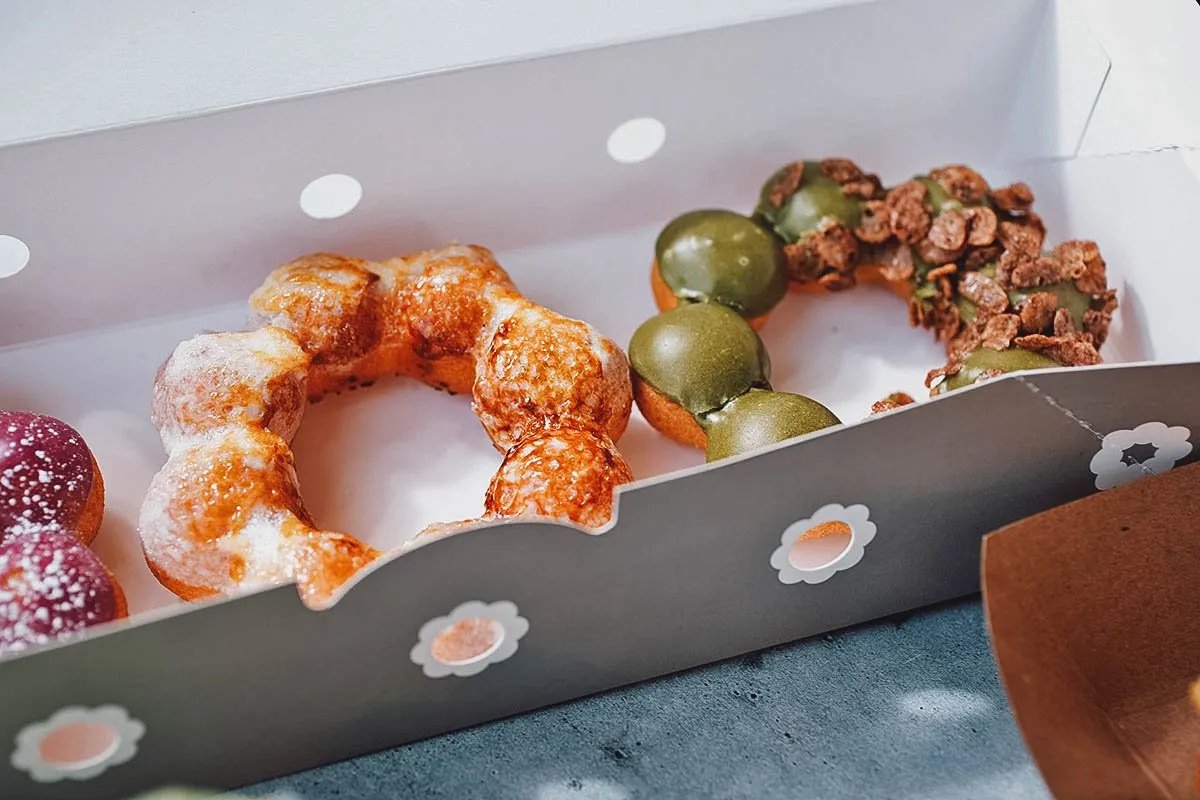
Photo by sai0112
BONUS: Sushi Donuts (Japanese-American)
Ok, so these aren’t really donuts, but they’re just too pretty not to include so I’ve added them here as a bonus.
Sushi donuts are artful presentations of raw fish, seafood, and vegetables served over rings of sushi rice. They’re the brainchild of Project Poke in Orange County, California and debuted sometime in 2016. Pretty right?
Never thought I’d be saying “sushi” and “donut” in the same sentence but here we are. Thank you Instagram.
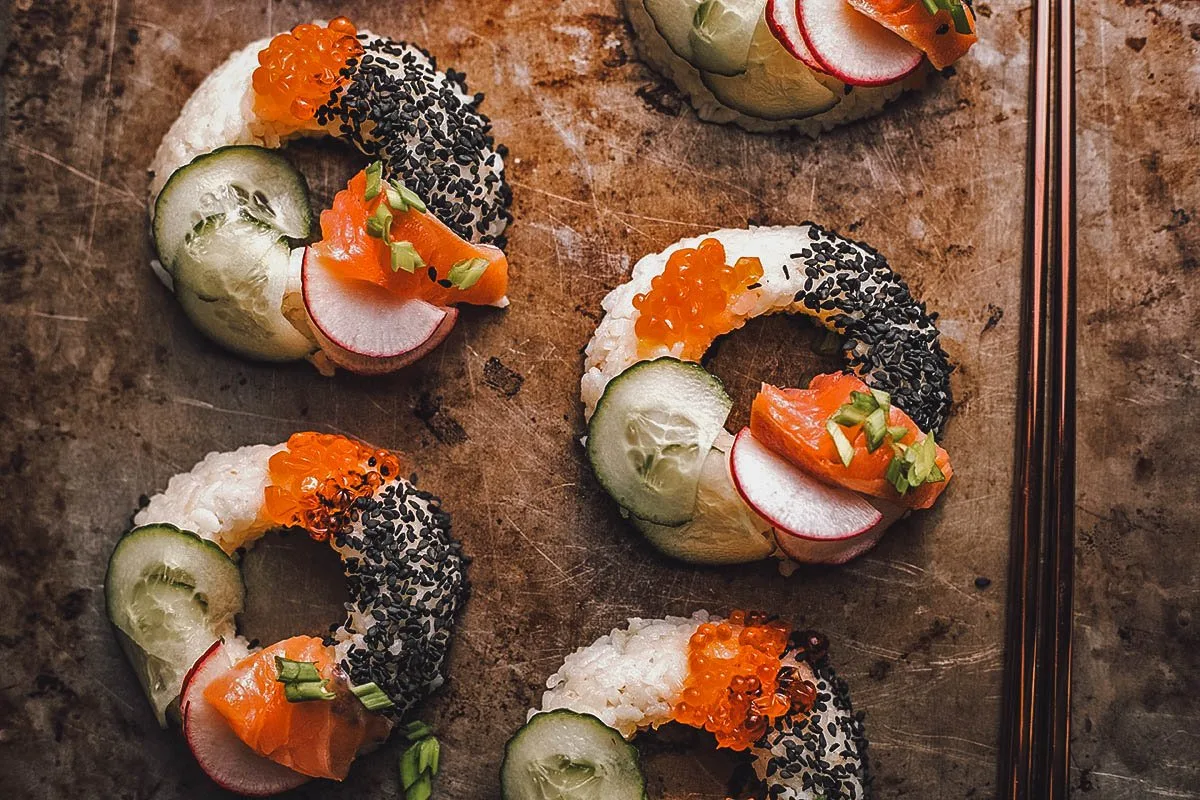
Photo by sokor
25. Youtiao (China)
Youtiao are among the most well-known types of donuts from Asia. Also known as Chinese crullers, they’re long breadstick-like donuts that can be eaten plain with savory breakfast dishes or as a sweetened dessert.
Youtiao are originally from China but they’re consumed in many countries throughout East Asia and Southeast Asia like Taiwan, Singapore, Malaysia, and Thailand. It’s a versatile dish that can be enjoyed in many ways.
Youtiao can be dipped into savory and sweet liquids, wrapped in rice noodle rolls, used as a stuffing in flatbread, and more.
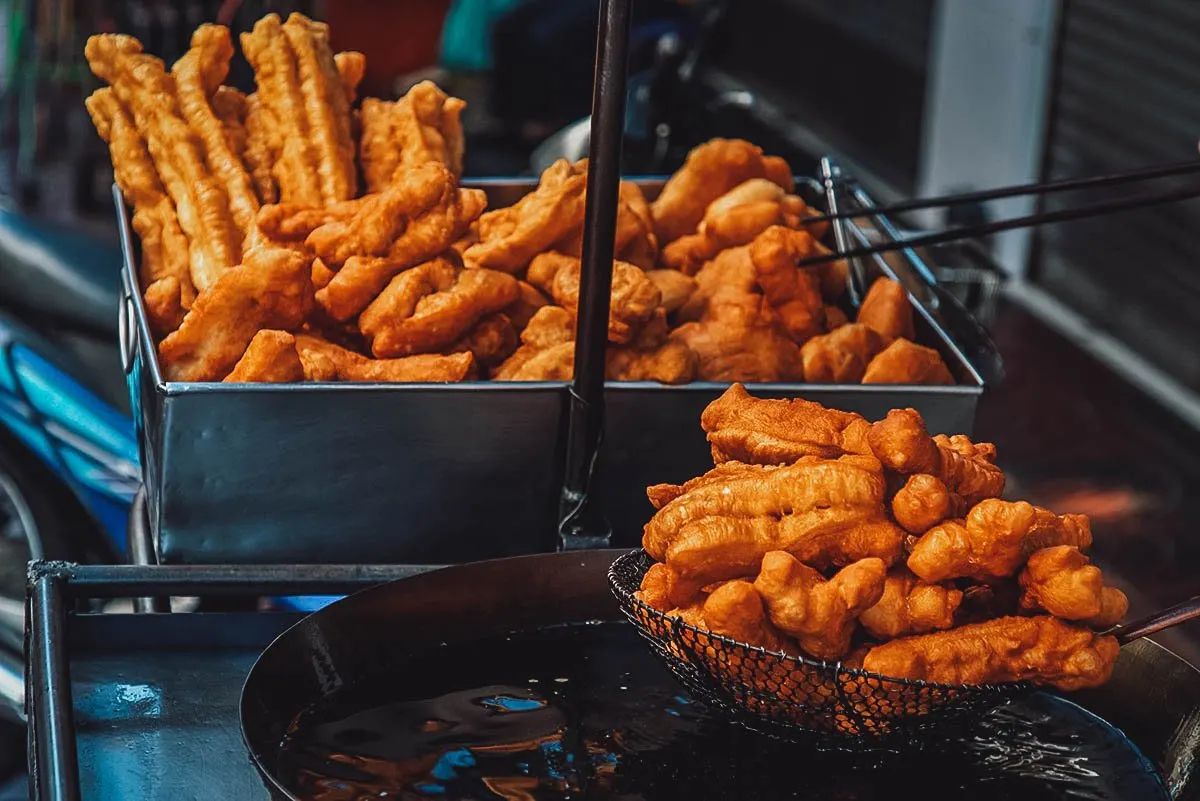
Photo by sokor
26. Jiandui (China)
Growing up in Asia, we always looked forward to these red-bean-filled sesame balls at Chinese restaurants. I never thought of them as donuts but you can say that they are. By definition, jiandui or Chinese sesame balls are essentially a type of filled drop donut.
Jiandui are Chinese pastries made with glutinous rice flour. About the size of ping pong balls, they’re coated with sesame seeds and usually filled with either red bean paste or lotus paste. Like youtiao, they’re popular in many parts of Asia like Hong Kong, Japan, Vietnam, and the Philippines.
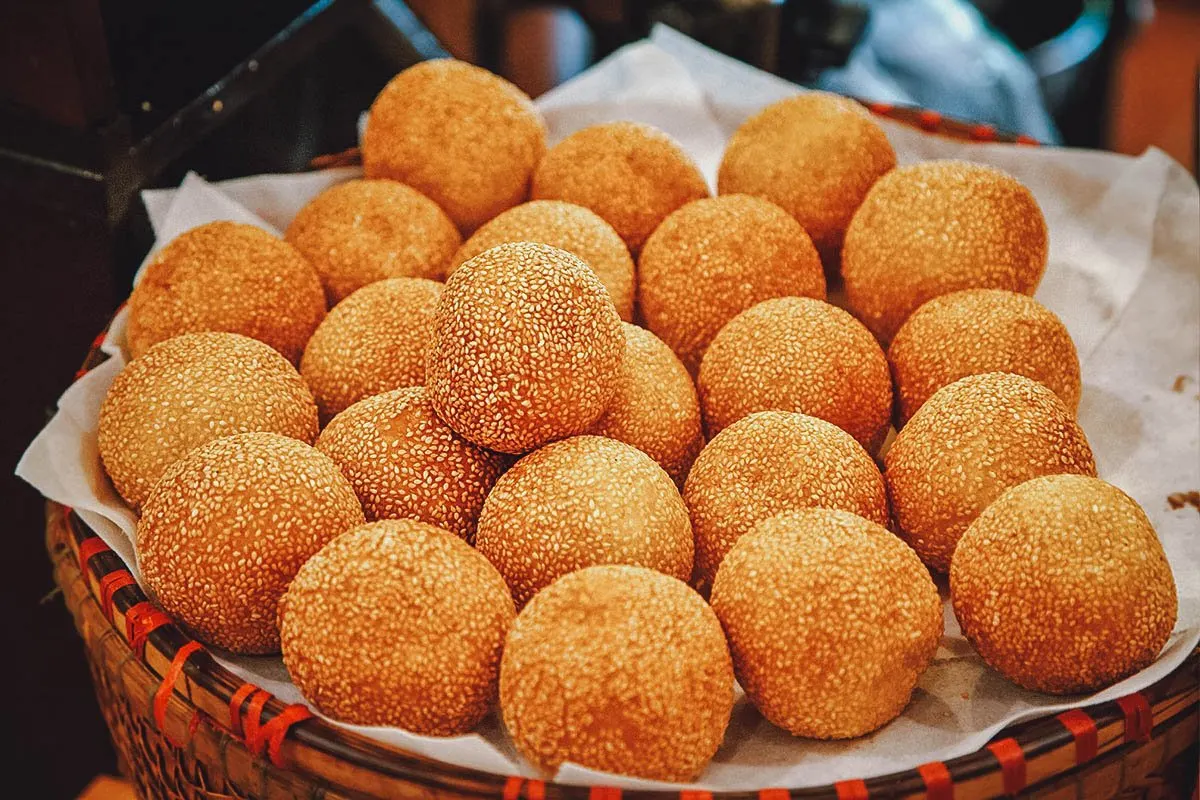
Photo by e.m.mitroshin.gmail.com
27. Shuangbaotai (Taiwan)
These oddly-shaped Taiwanese donuts are known as shuangbaotai. Also referred to as “horse hooves” thanks to their unusual appearance, they’re made by twisting two pieces of dough together before frying them. While frying, they puff up and separate slightly while still staying together.
I’ve never actually seen these in Taiwan but shuangbaotai are said to be available at Taiwanese night markets.
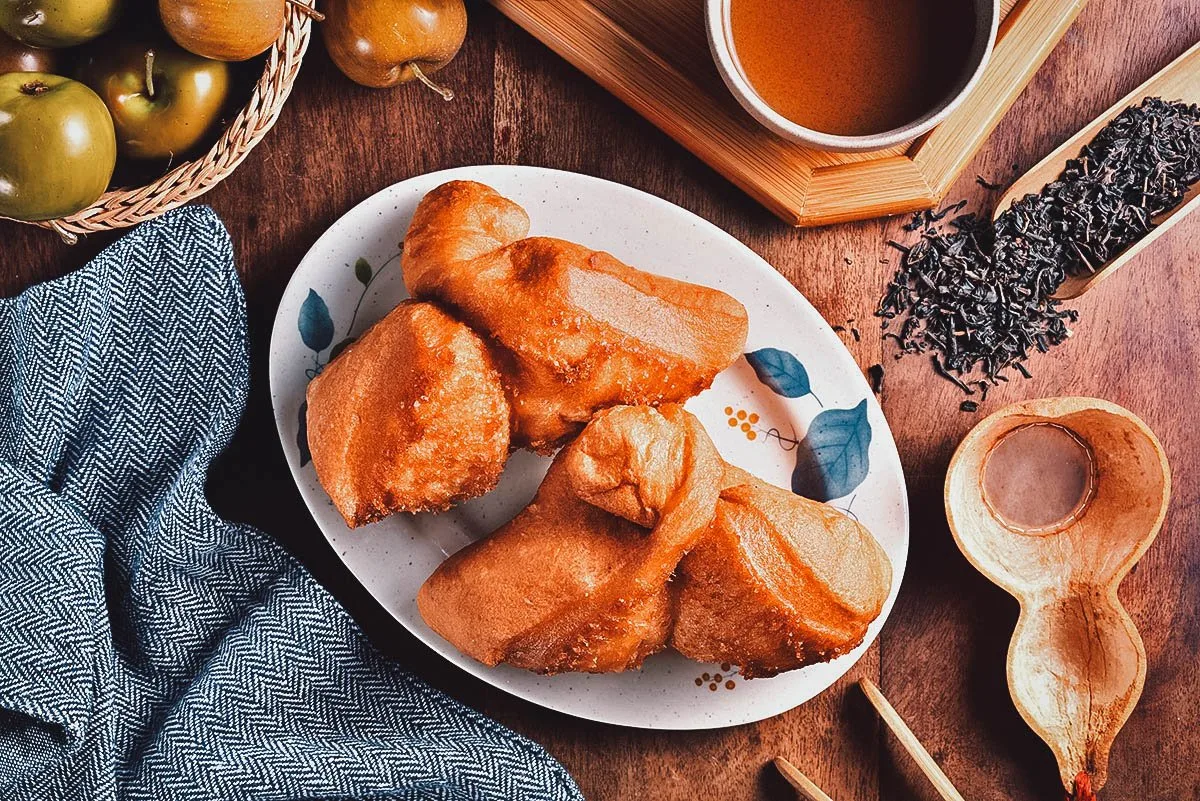
Photo by lcc54613
28. Noum Kong (Cambodia)
Visit any market in Cambodia and you’re sure to find vendors frying up these delicious donuts known as noum kong. Dipped in a glaze of liquified palm sugar and coated in sesame seeds, they have a crisp exterior and a soft, mochi-like interior thanks to the use of sticky rice flour in the batter.
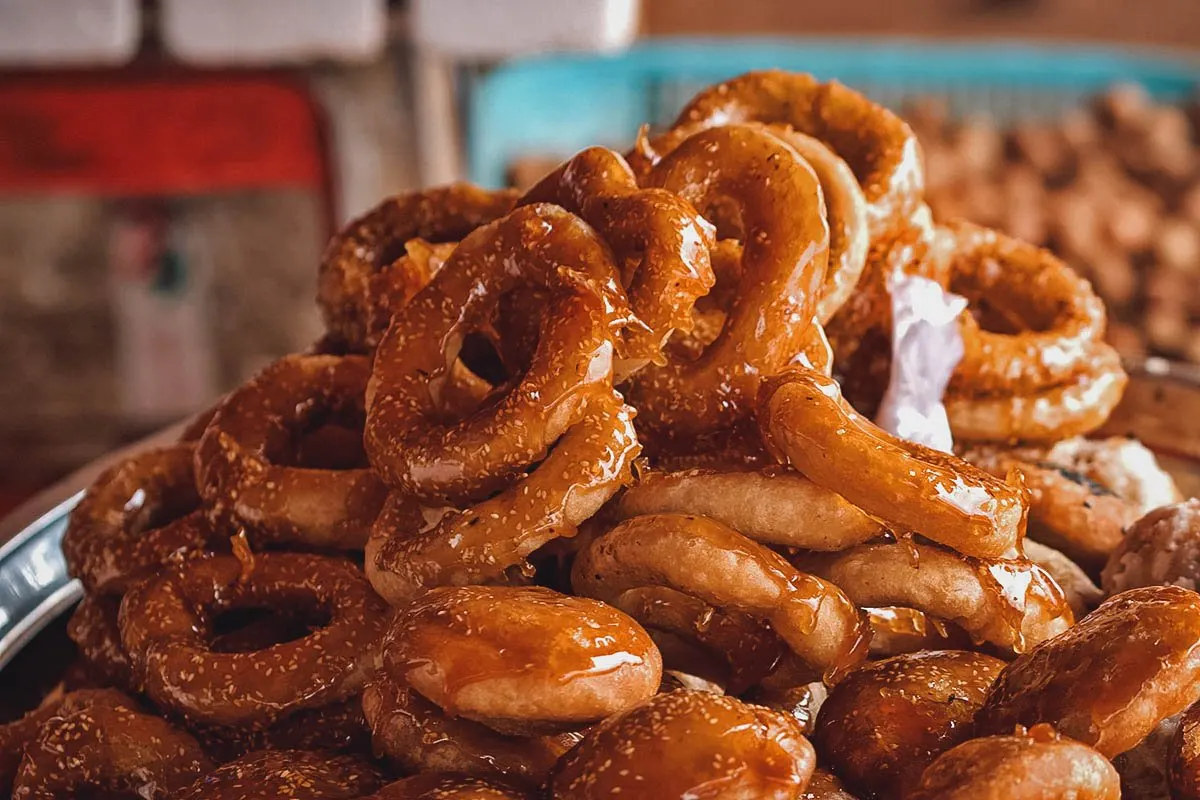
Photo by Stockcrafter
29. Donat Kentang (Indonesia)
If you like spudnuts, then you need to try donat kentang on your next visit to Indonesia. It refers to the light and fluffy Indonesian version of potato donuts. Donat kentang, in Bahasa, literally means “potato donuts”.
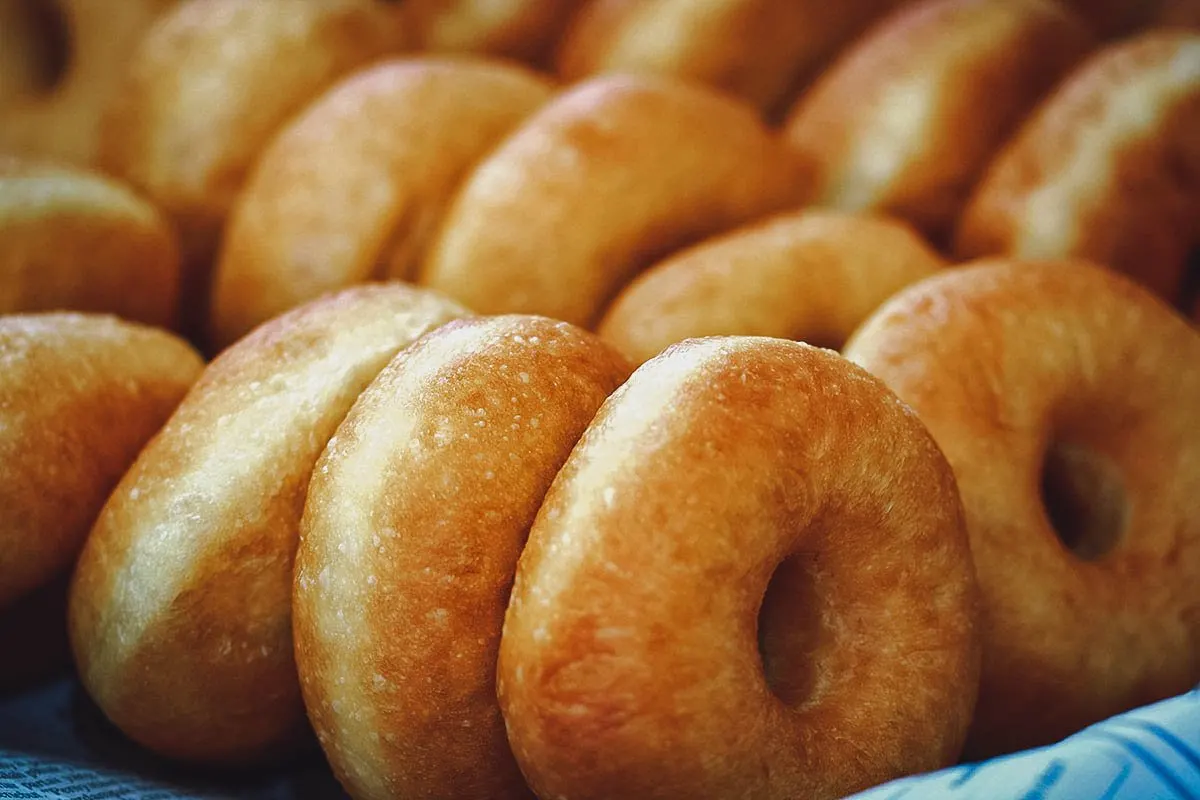
Photo by [email protected]
30. Shakoy (The Philippines)
I grew up around these twisted pieces of fried dough in the Philippines but I never thought of them as donuts. As a kid, you think of donuts as rings so it never occurred to me that shakoy was in fact a type of Filipino donut.
Also known as lubid-lubid (“ropes”), shakoy is a twisted, stick-like Filipino donut that’s commonly found at local bakeries.
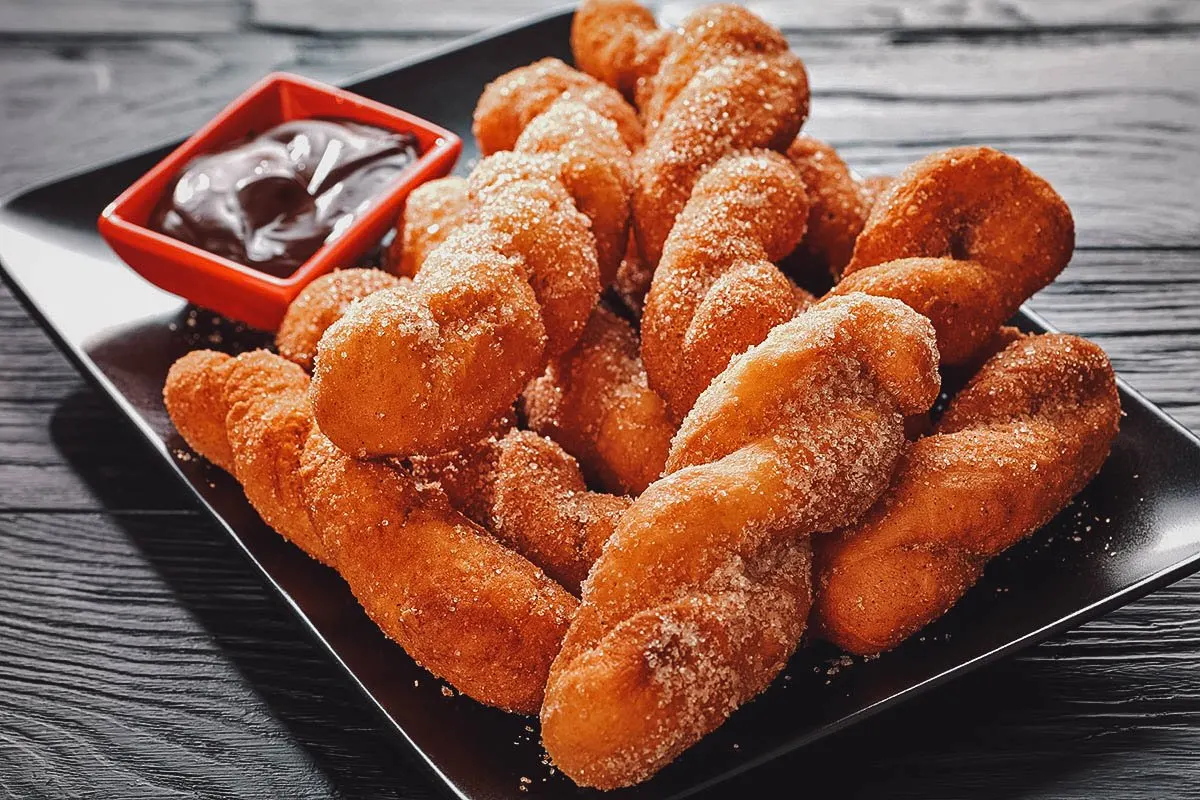
Photo by myviewpoint
31. Pa Thong Ko (Thailand)
Pa thong ko refers to the Thai version of Chinese youtiao. It’s typically eaten for breakfast with jok (congee), or as a dessert snack with sweet dips like condensed milk or pandan custard.
If you ever visit Bangkok, then be sure to look for the Michelin-recommended pa thong ko stall in Chinatown. Pa thong ko is delicious enough on its own but a Michelin-recommended Thai donut? Aroi!
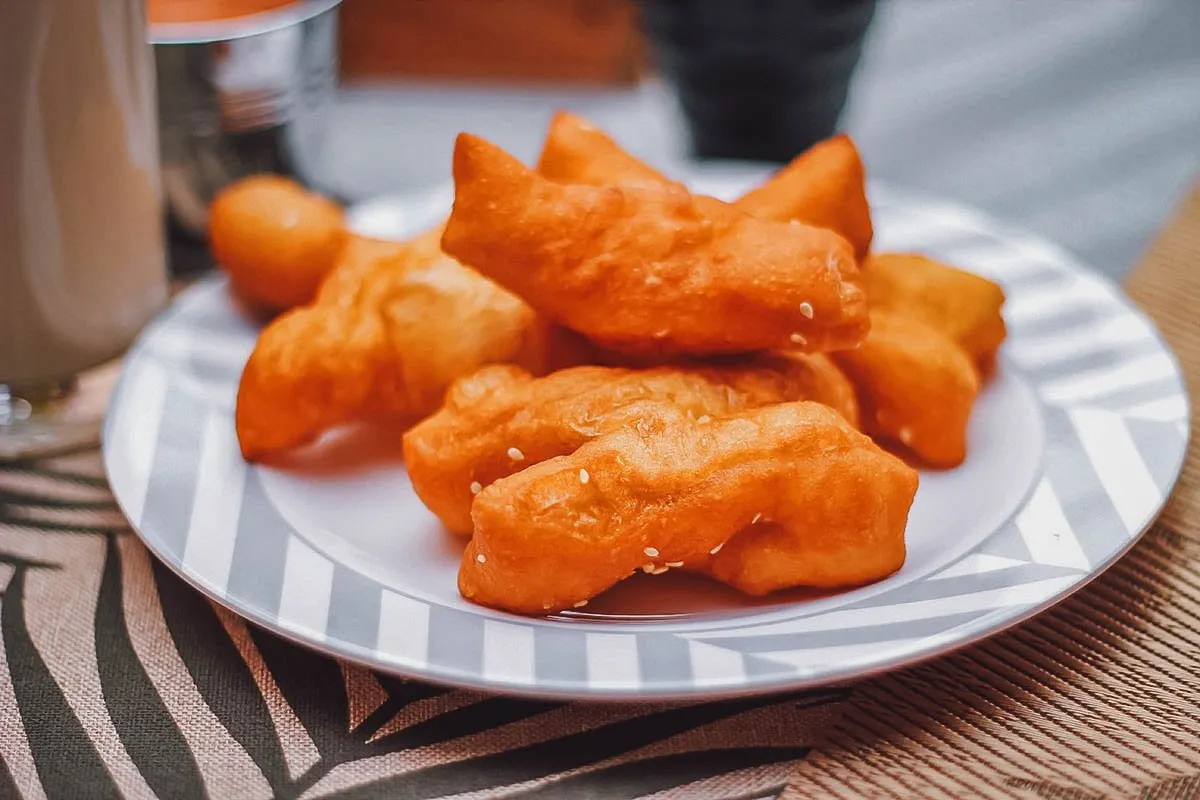
Photo by birchphotographer
32. Vada (India)
Vadas are another great example of a savory type of donut. It refers to a family of deep-fried Indian dishes made with batter using different ingredients like chickpeas, potatoes, mung beans, and sago. They’re commonly enjoyed for breakfast or as a snack, often with chutneys and sambar and as part of other dishes like vada pav and dahi vadas.
Vadas are an important part of Indian cuisine and can be prepared in a number of ways. One of the most popular is medu vada (pictured below). It’s made with black gram and shaped like ring donuts.
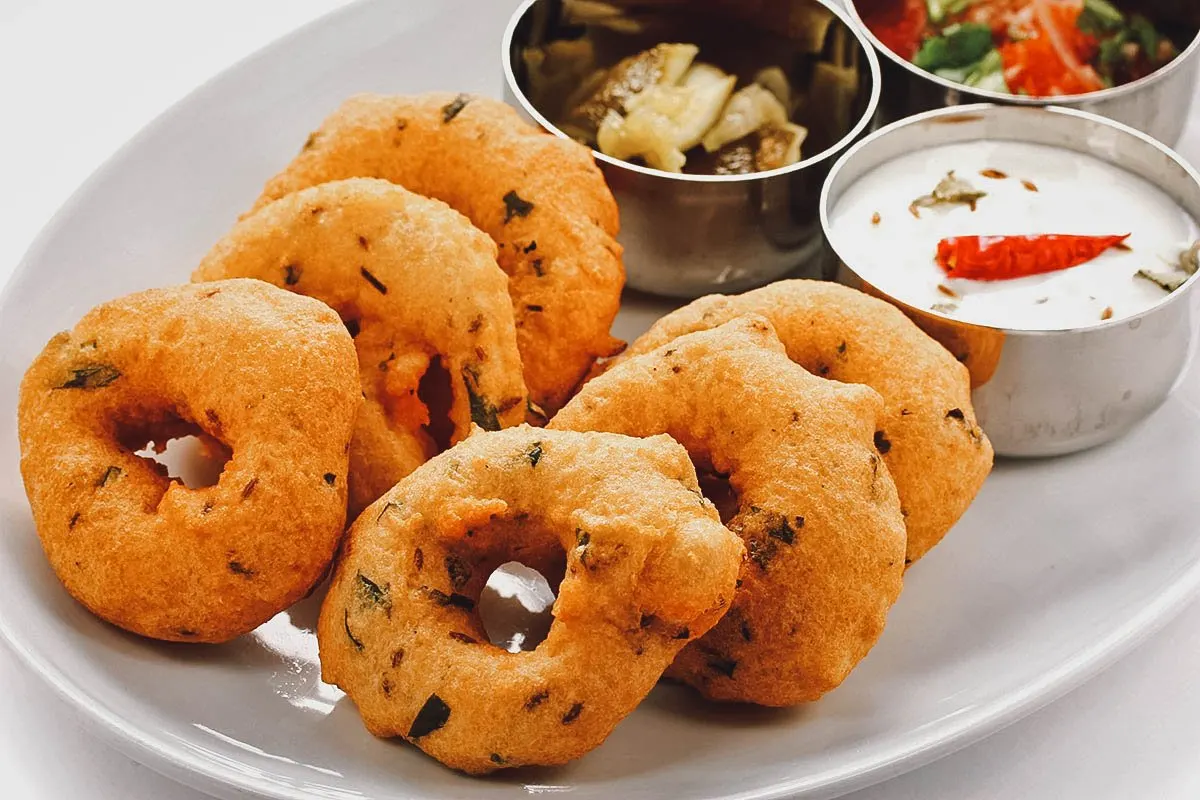
Photo by asimojet
33. Gulgule (India)
Gulgule are sweet north Indian donuts made from whole wheat flour, jaggery, and fennel seeds. Crispy on the outside and soft and fluffy on the inside, they’re a favorite snack to enjoy with hot Indian tea.
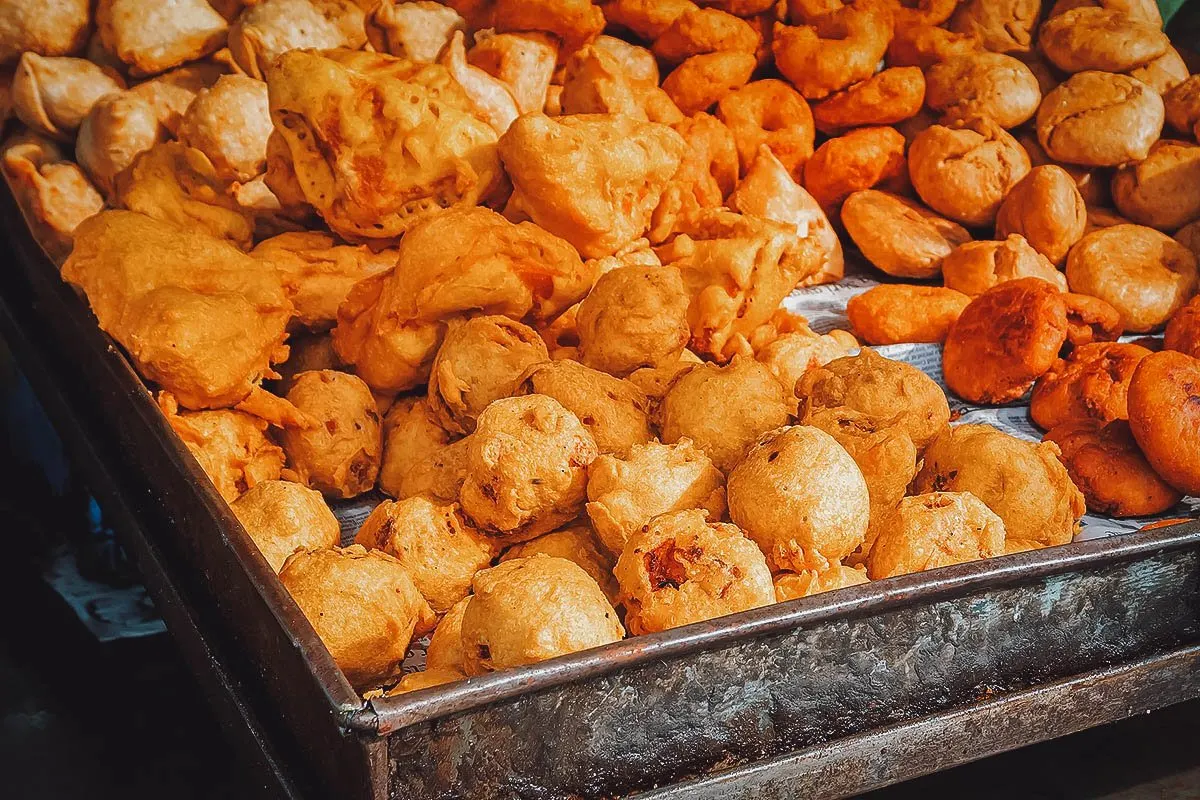
Photo by Mitrarudra
34. Sel Roti (Nepal)
Sel roti refers to a type of ring-shaped Nepalese donut deep-fried in oil or ghee. It’s made from rice flour, milk, butter, and sugar mixed with other flavorings like cardamom and cloves.
Sel roti is an important dish in Nepalese culture and cuisine. It’s a festival food that’s typically prepared to celebrate Hindu festivals like Dashain and Tihar.
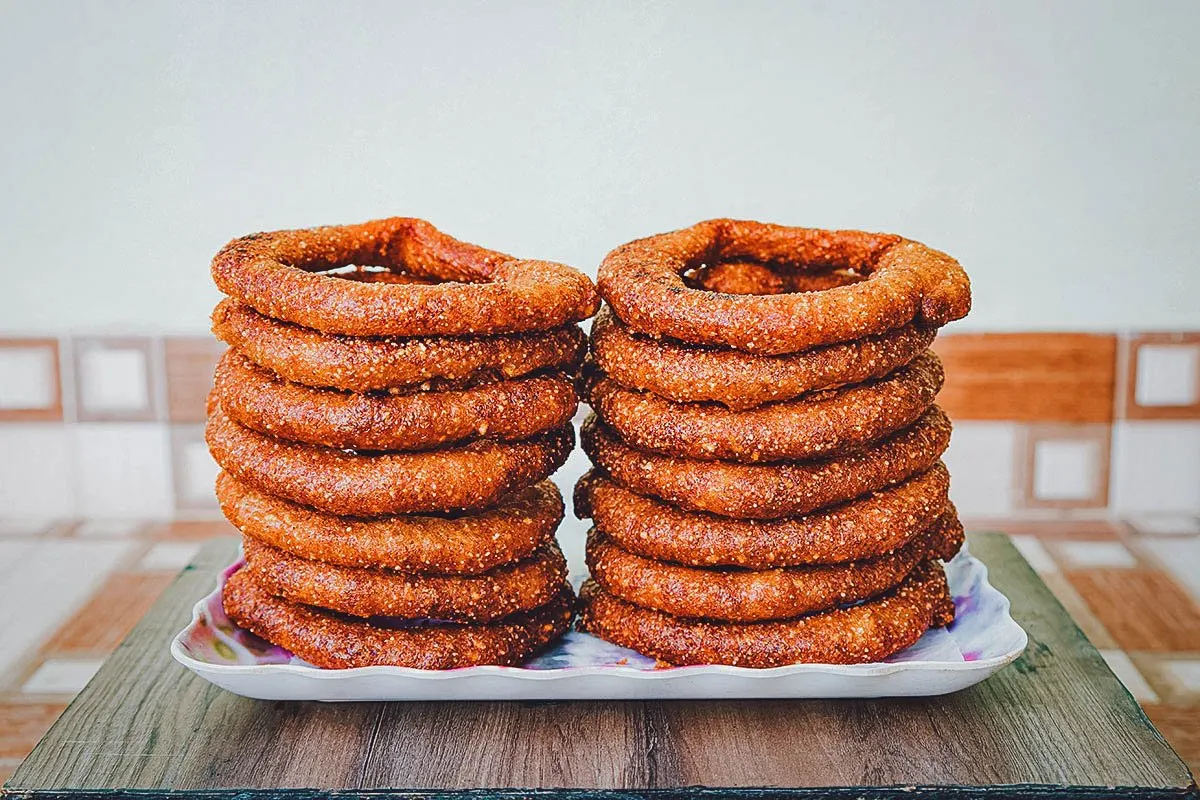
Photo by Idealnabraj
35. Tulumba (Turkey)
Tulumba refers to Turkish donuts made from fried unleavened dough soaked in sweet, aromatic syrup. They’re very similar to jalebi but they look like short fat churros. Like Spanish churros, they get their ridges from being piped through a pastry bag with a star-shaped nozzle.
Tulumba is originally from Turkey though it’s become common in the cuisines of many countries throughout the Balkans and the Middle East like Greece, Serbia, Bosnia and Herzegovina, and Iran.
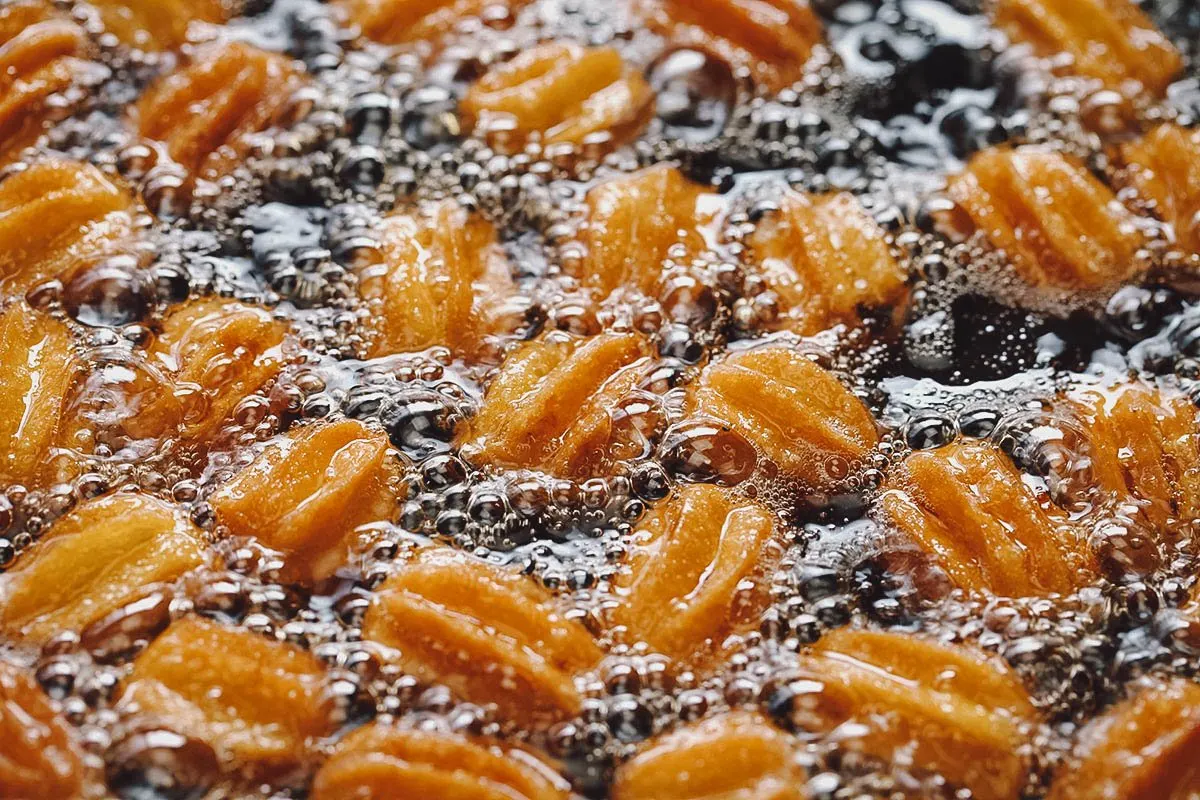
Photo by asimojet
36. Sufganiyot (Israel)
Sufganiyot are filled Israeli donuts typically prepared to celebrate Hanukkah. Like berliners, paczki, or krafne, they’re filled with either jam or custard and given a generous dusting of powdered sugar.
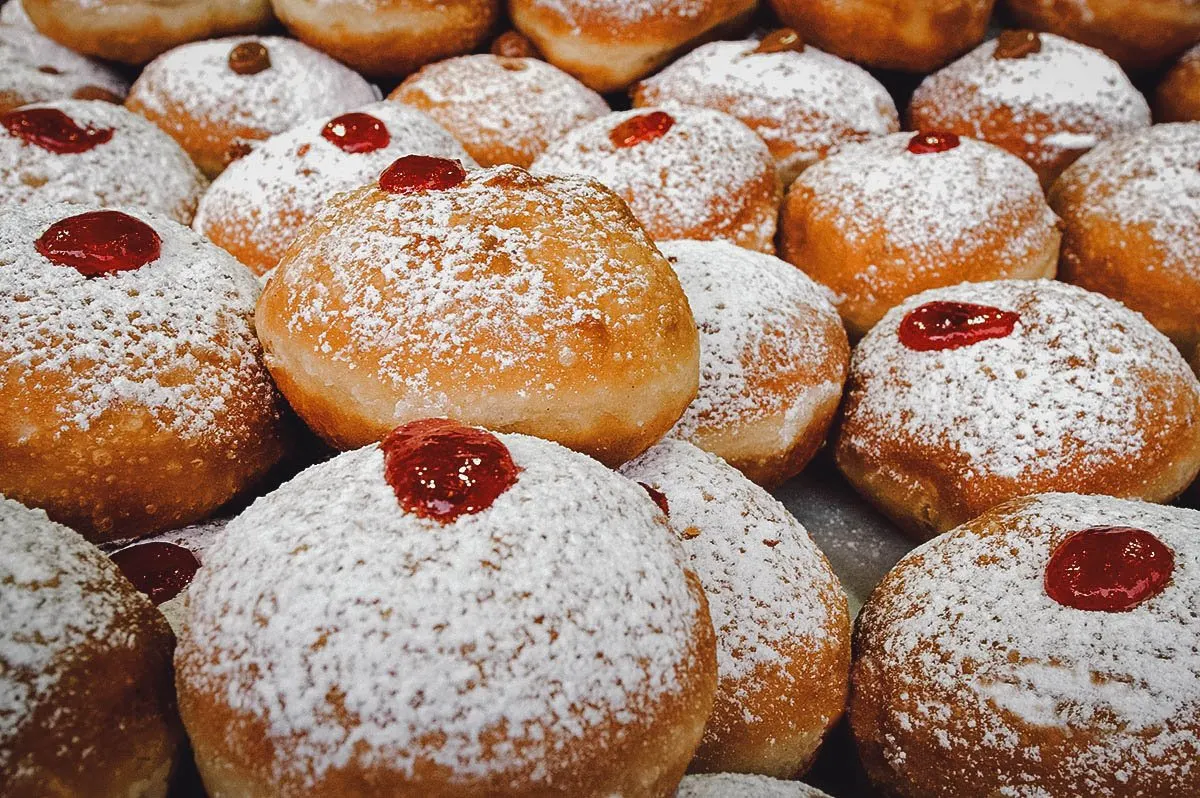
Photo by lucidwaters
AFRICA
37. Sfenj (Morocco)
Sfenj refers to a type of Maghrebi donut commonly consumed in Morocco. It’s a light and spongy donut that’s typically eaten for breakfast or as an afternoon snack with tea or coffee. It can be served plain, soaked in honey, or sprinkled in sugar.
Sfenj donuts are a popular street food in Morocco but they’re also common in other North African countries like Algeria, Libya, and Tunisia. In Libya, they’re known as sfinz while in Tunisia, they’re referred to as bambalouni.
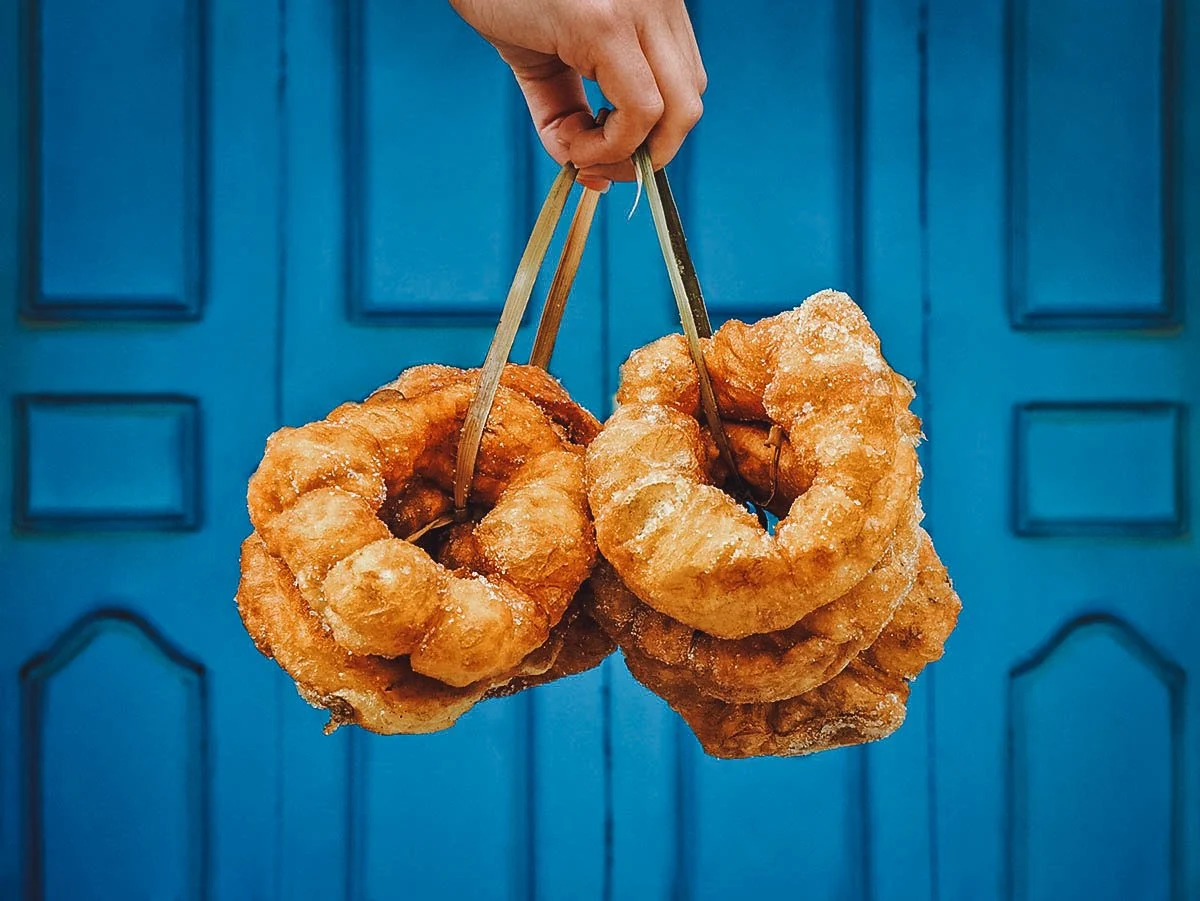
Photo by luaeva
38. Koeksister (South Africa)
Koesister refers to another type of braided or twisted donut, this time from South Africa. It’s coated in a sticky-sweet syrup and has a crunchy crust with a soft syrupy interior.
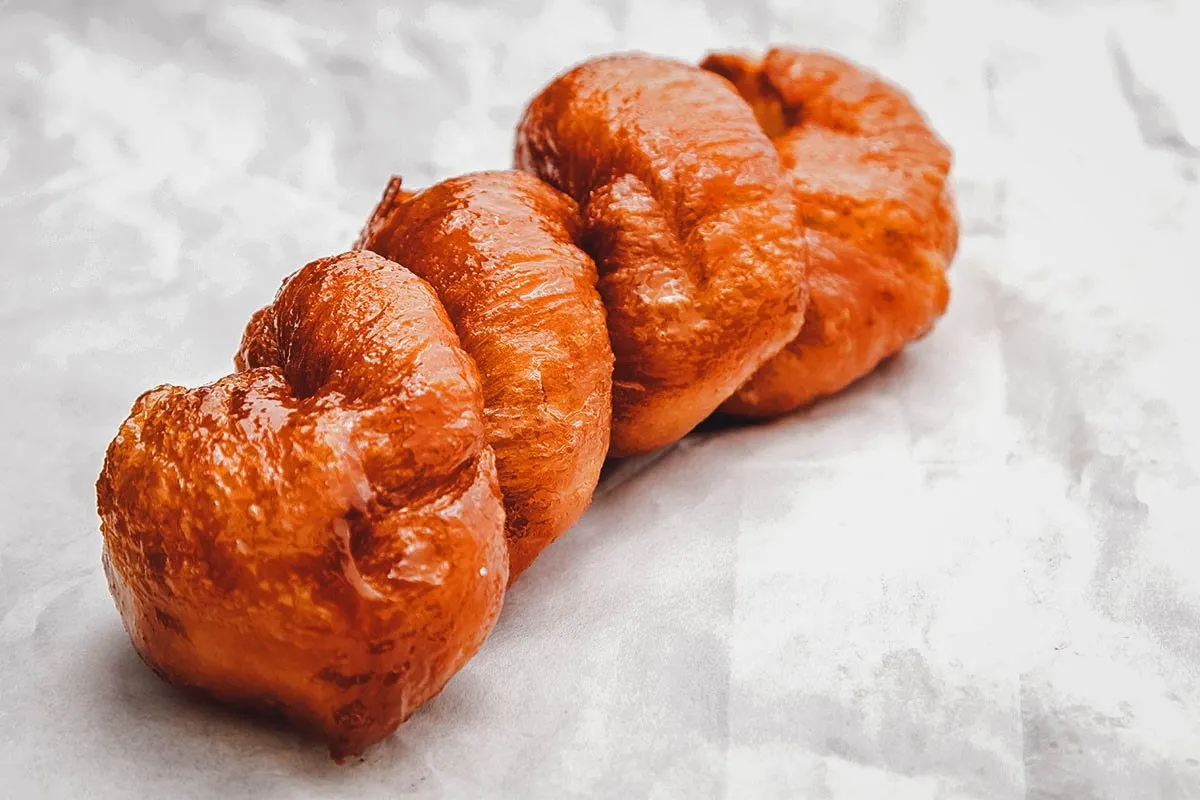
Photo by Wirestock
39. Vetkoek (South Africa)
Vetkoek is another type of donut that can be sweet or savory. Meaning “fat cake” in Afrikaans, it’s a popular South African street food dish that can be eaten with syrup, jam, or honey or sliced open and stuffed with a variety of different ingredients like ground meat, tuna, chicken with mayo, and cheese.
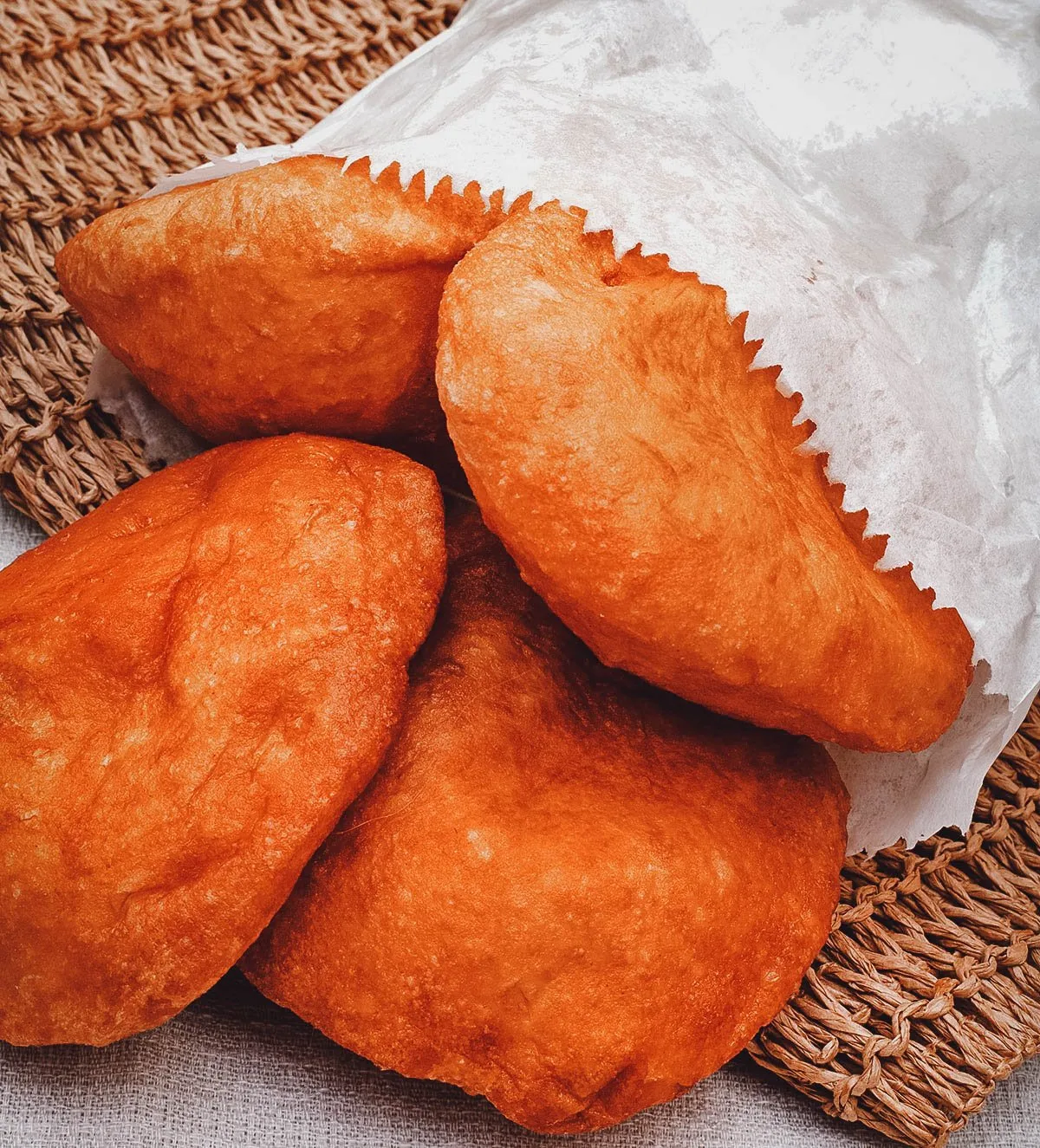
Photo by AninkaBongersSutherland
Vetkoek can basically be used as a vessel for any type of filling but the most popular is curried minced beef. Known as “curry bunnies”, these tasty donut sandwiches are a common sight at street food stalls and fast food shops throughout South Africa.
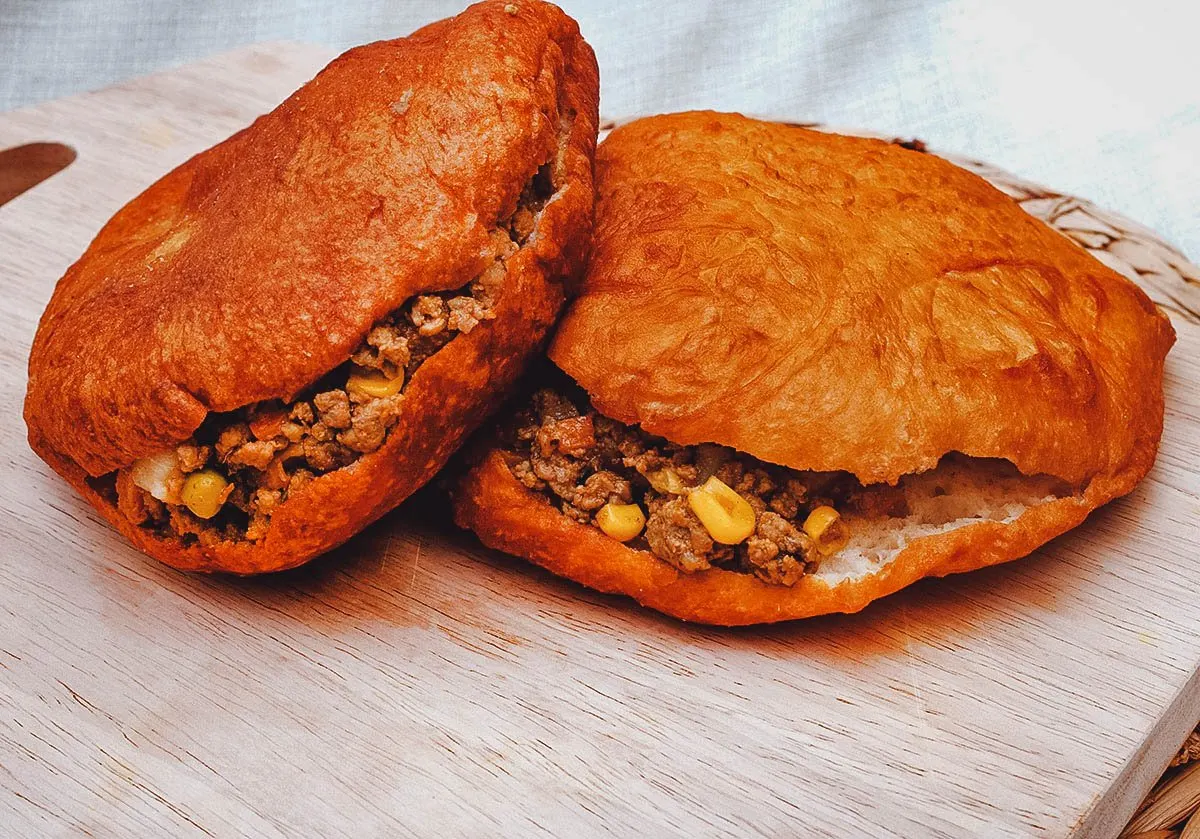
Photo by AninkaBongersSutherland
OCEANIA
40. Hot Jam Doughnuts (Australia)
Australian hot jam doughnuts are an interesting take on berliners. Unlike other types of jelly donuts that are eaten at room temperature, hot jam donuts are always eaten hot. The balls of yeasted dough are filled with jam before being tossed in the fryer.
Hot Jam doughnuts are a Melbourne creation where they’re also known as Melbourners. Dusted with icing sugar immediately after frying, they’re designed to be eaten fresh and hot.
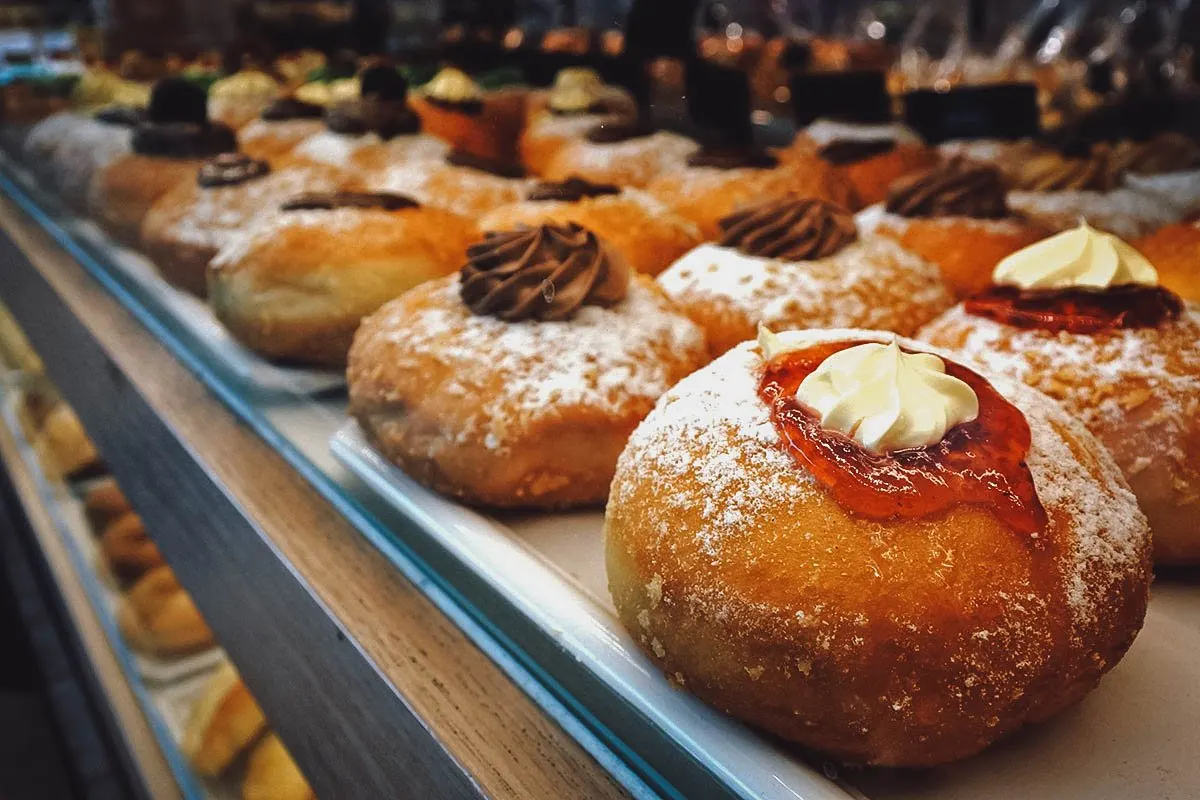
Photo by lucidwaters
FINAL THOUGHTS ON THE DIFFERENT TYPES OF DONUTS FROM AROUND THE WORLD
Like ice cream flavors, new types of donuts and donut flavors are being created everyday. Just walk into any innovative donut shop like Voodoo Doughnut and you’ll find an endless variety of donuts topped with oddball ingredients like bubble gum dust and Cap’n Crunch cereal.
Donuts topped with whole pieces of bubble gum may be too extreme for me but one flavor that I would love to try is the maple bacon donut. Maple frosting with crunchy bits of bacon sounds like a match made in salty-sweet heaven.
Lastly, when doing research for this article, I came across another type of donut that I’ve never heard of before – the Pershing. Also known as a “Persian roll“, it looks like a cinnamon roll but it’s deep-fried like a donut.
So many types of donuts, so little time.
Cover photo by bhofack2. Stock images via Depositphotos.


Donuts Near Me
Wednesday 8th of November 2023
Very nice blogs share for donuts.
Larry Hosken
Sunday 30th of July 2023
This article is awesome. "Orange Country" should be "Orange County"
JB & Renée
Tuesday 1st of August 2023
Thanks for the catch Larry!
Angela
Sunday 16th of July 2023
You haven't tried the best donuts until you've eaten donuts from Horst's Little Bakery Haus in Madison, Indiana!
Quana Alexander
Sunday 18th of December 2022
What an amazing list! These all look amazing! Puff Puff from Nigeria is missing though.